Cuba Travel Guide
Welcome to the taste2travel Cuba Travel Guide.
Date Visited: November 2015
Introduction
Once a favoured hedonistic destination for American celebrities and socialites, Cuba had a reputation as an exotic and permissive playground.
In the early 20th century, Cuba’s ideal tropical beaches attracted the American masses who could purchase cheap package tours from Florida, which included round-trip tickets from Miami, hotel, food and entertainment.

Colourful houses line the cobbled streets of the quant old town of Trinidad.
The island also attracted famous celebrities such as Ava Gardner, Frank Sinatra and Ernest Hemingway, who loved Cuba so much he relocated to Havana.
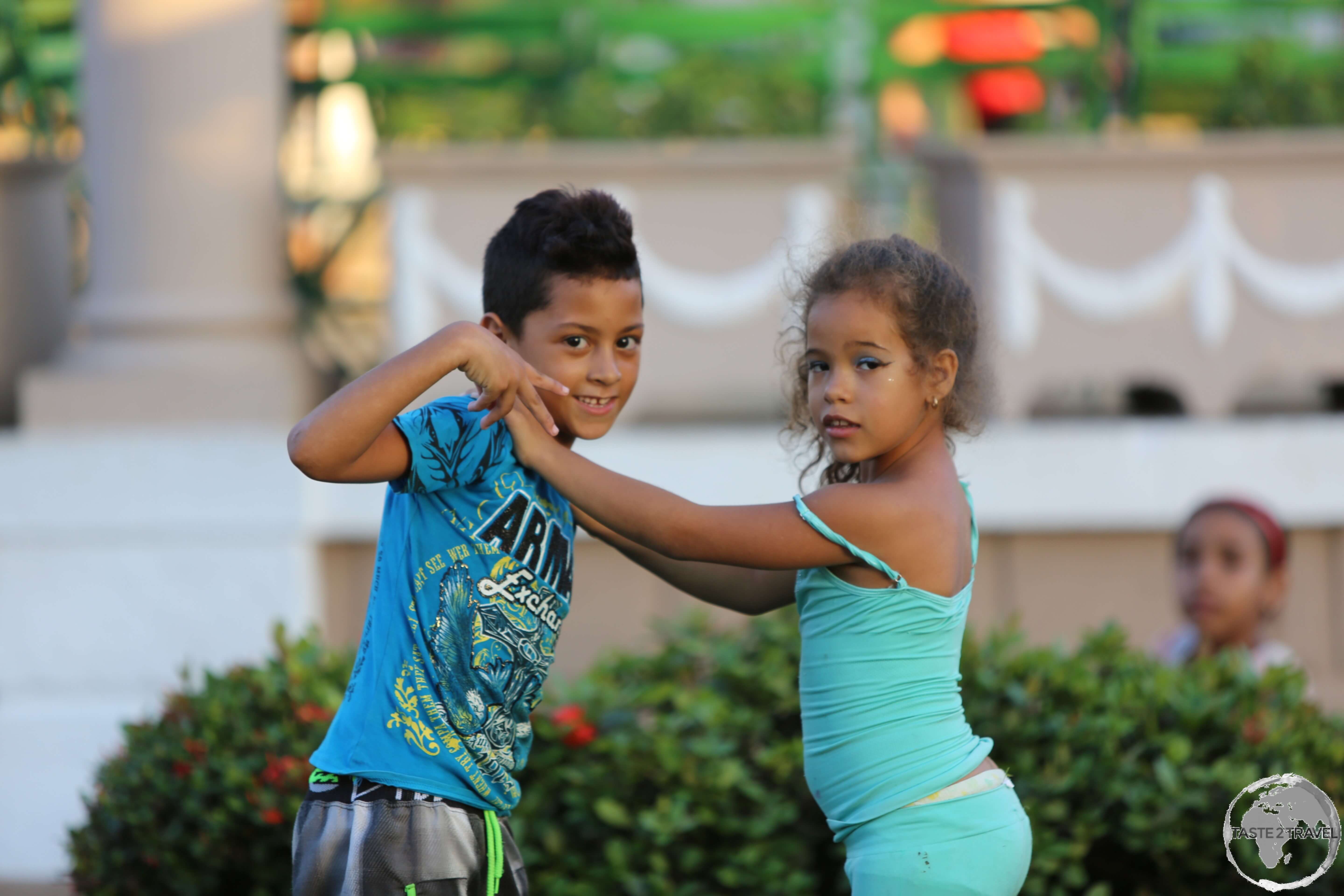
Children playing in Plaza José Martí in Cienfuegos.
The party ended in 1959 when a young Fidel Castro, having overthrown the corrupt President – Fulgencio Batista, came to power, installed a communist government and promptly destroyed all symbols of the hedonistic past, including casino’s and resorts.
This effectively ended tourism in Cuba with visitor numbers plummeting from 350,000 visitor’s in 1957 to 4,000 in 1961.

Young girls in Sancti Spiritus.
In 1963, the United States government delivered the final blow by enacting the trade and travel embargo (still in place today), closing off the popular Caribbean playground to Americans.

Souvenir Cuba flag license plates on sale in Havana old town.
Under the Obama administration there was a thaw in relations and a hope that the embargo would finally be lifted by congress. President Trump, through a series of initiatives, is now working to reverse the progress made under Obama, including a tightening of the trade embargo.
With a population of almost 12 million, Cuba is the most populous nation in the Caribbean and, with an area of 109,884 km2 (42,426 square miles), is the largest Caribbean island.
Most Cubans are employed by the state, earning an average salary of US$20 per month. This meagre wage is offset (somewhat) by the distribution of Ration books, which provide families with a variety of essentials at heavily subsided prices.
Despite the hardships of everyday life, Cubans are generally gregarious, happy, hospitable, outgoing and vivacious. They have a great sense of humour, are highly educated, and love their music, dancing and rum.

School children in Havana old town.
In 2016, Cuba attracted a record four million tourists, many of them arriving on cruise ships, carrying US passports. Cruise ship arrivals increased from 24 in 2012 to 139 in 2015.
The Ministry of tourism has forecast more exponential growth in the coming years, all thanks to an increase in visitors from the United States. Despite the setbacks from the current US administration, the floodgates have been opened and American tourists are once again flocking to this Caribbean jewel.

Young girl in the old town of Trinidad.
Location
Havana, Cuba
A bastion of socialism lying 90 miles south of a bastion of capitalism! Cuba is located in the Caribbean Sea, at the confluence of the Gulf of Mexico and the Atlantic Ocean.
Cuba is an archipelago consisting of more than 4,000 islands and cays, with almost everyone and everything located on the main island of Cuba.
The United States lies across the Straits of Florida, with Key West just 90 miles north of Havana. Other neighbouring countries include the Bahamas – 21 kilometres (13 miles) to the north, Haiti – 77 kilometres (48 miles) to the east, Jamaica – 140 kilometres (87 miles) southeast and the Cayman Islands – 437 kilometres (272 miles) to the south.
History

The ceiling fresco Revolucion in the Museo de la Revolucion, Havana.
Like so many other Caribbean islands, the history of Cuba can be broken into a pre-Colombian period, a colonial period, and a period of independence.
Pre-Colombian Era
Cuba was first settled around 3,000 BC by the native Guanajatabey, who lived for centuries on the island, until the arrival of waves of migrants from the east – including the powerful native Indian Taíno.
The Taíno originally entered the Caribbean from South America and at the time of Columbus’ arrival they occupied most of the islands in the Caribbean. These original settlers were agricultural specialists and gave Cuba its name, which translates as either “where fertile land is abundant” (Cubao), or a “great place” (Coabana).
Once settled, they divided Cuba into 29 chiefdoms, forcing the remaining Guanajatabey to the far western end of the island – into the area which is now Pinar del Rio province.
When Columbus arrived and claimed Cuba for Spain, the Spanish used the existing Taíno settlements as the sites for their future colonial cities, retaining the original Taíno names in places such as Havana, Camagüey and Baracoa,
Colonial Cuba
Christopher Columbus was the first European to discover Cuba, arriving from the Bahamas during his first voyage to the New World in 1492. Columbus was looking for a route to India and believed Cuba was part of Asia.
During his second voyage in 1494, he mapped the south-east coast but the entire island was not fully mapped until 1509. In 1511 the Spanish sailed from Hispaniola to Cuba to establish their first settlement at Baracoa.
The Spanish faced stiff resistance from the well organised Taíno’s which led to 3 years of conflict. Once the chieftains had been captured (and burnt alive) the Spanish gained control of the island and in 1514 established a settlement in what was to become Havana.
The Spanish Crown installed Diego Velázquez de Cuéllar as the first governor of Cuba – originally residing in Baracoa then later Havana. The Spanish turned the island into an agricultural powerhouse, importing an army of slaves to work on sugarcane plantations. Tobacco plantations employed ‘free’ slaves as the work was considered delicate and was not suited to someone working under ‘forced’ conditions.
As Cuba became more prosperous, so too it become a frequent target of attack from other colonial powers – notably the British, who managed to occupy Havana for a brief period in 1762, before returning it to Spain in exchange for Florida.
A series of rebellions during the 19th century failed to end Spanish rule. However, the Spanish–American War resulted in a Spanish withdrawal from the island in 1898. The US military occupied the island for three-and-a-half years before the country gained independence in 1902.
Independent Cuba
In the years following its independence, the Cuban economy flourished but was prone to political corruption and was ruled by a succession of despotic leaders. Into the fray stepped a young revolutionary – Fidel Castro who managed to overthrow of the ruling dictator Fulgencio Batista on the 1st of January 1959.
Flag

The flag of Cuba.
The national flag of Cuba consists of five alternating stripes (three blue and two white) and a red equilateral triangle at the hoist, within which is a white five-pointed star. It was designed in 1849 and officially adopted on the 20th of May, 1902.

A Cuban flag in Trinidad old town.
Puerto Rican v Cuban Flag
It’s no mistake that the flag of Puerto Rico is identical in design to the Cuban flag, except that the colours are inverted. The revolutionaries who designed the Puerto Rican flag were ‘brothers-in-arms‘ with their Cuban counterparts, especially Jose Marti, who approved the design for the newly independent state.

The flag of Puerto Rico.
¡Viva la Revolución!
Fidel Castro
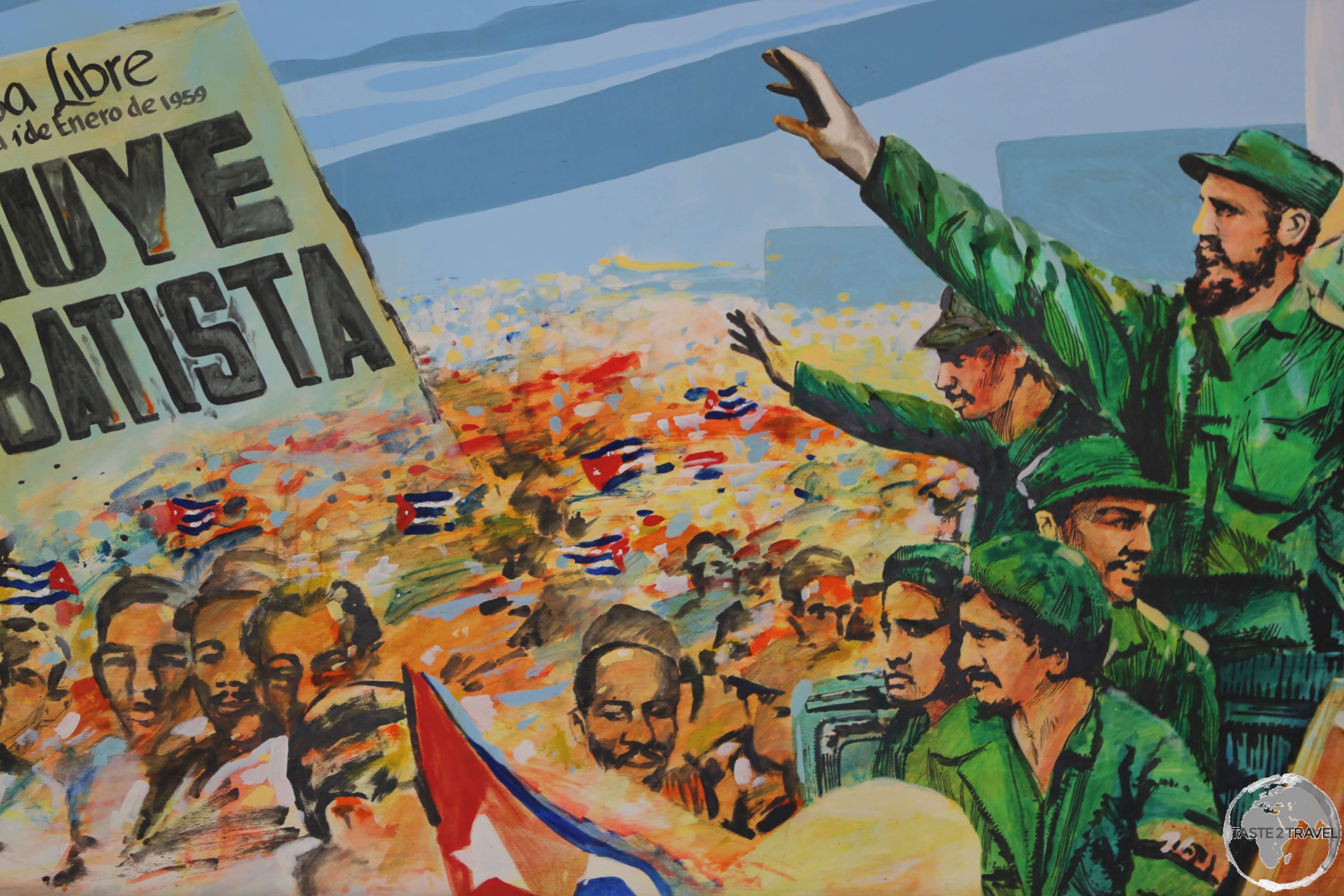
A propaganda painting in Havana’s Museo de la Revolucion celebrates the overthrow of former President Bautista by Fidel Castro.
Fidel Alejandro Castro Ruz was born into a rich Spanish farming family in Cuba. During his years of studying law at the University of Havana he adopted leftist anti-imperialist politics.
Following his studies, he participating in rebellions against right-wing governments in the Dominican Republic and Colombia, after which he planned to overthrow the Cuban President Fulgencio Batista. His first attempt failed when he launched a failed attack on the Moncada Barracks in 1953 (see ‘Sights – Santiago de Cuba‘ below).
After the attack he was thrown into prison, after which he relocated to Mexico where he formed a revolutionary group, the 26th of July Movement, with his brother Raúl Castro and Che Guevara.
Upon his return to Cuba, Castro played a key role in the Cuban Revolution by leading the Movement in a guerrilla war against Batista’s forces. In 1959 the revolution prevailed and Batista was overthrown.
After the coup, Castro consolidated his power by brutally marginalising other resistance groups and imprisoning and executing opponents and dissident supporters.
This led to an exodus of hundreds of thousands of Cubans who fled the island for the United States (90 miles to the north). Today there are more than two million Cubans living in the United States – mainly in Florida.
Castro passed away on the 25th of November 2016.
Che Guevara

A portrait of Ernesto “Che” Guevara at the Museum of the Revolution in Havana.
Born in Argentina, Ernesto “Che” Guevara first met Fidel Castro in Mexico in 1955 and decided immediately to join the Cuban revolutionary cause.
He returned to Cuba with Fidel aboard the Granma and was instrumental in training new recruits for the revolution. After the revolution succeeded, he assumed several key roles in the government including that of statesmen which saw him travel the world as a representative of the Cuban government, including a visit to the United Nations in New York City in 1964 where he gave an hour-long speech.
A video of the speech given to the United Nations by Ernesto “Che” Guevara.
Life as a bureaucrat was never easy for a restless revolutionary and so in 1965, Che wrote a farewell letter to Fidel Castro in which he affirmed his solidarity with the revolution and also resigned from all his positions in the Cuban government and communist party, and renounced his honorary Cuban citizenship.
In 1965, Che dropped out of public life and journeyed (incognito) to the Congo to join the revolution there – a revolution which failed soon after due to (in the words of Guevara) “the incompetence, intransigence and infighting among the Congolese rebels”.

A souvenir shop in Trinidad old town features the popular image of Ernesto “Che” Guevara.
In 1966, Che (who had now altered his image) arrived in Laz Paz to assist the Bolivian revolution. On the 8th of October 1967, two battalions of Bolivian soldiers (assisted by the CIA) conducted a raid on his remote compound at which point he was captured. The following day, fearing he would escape, the Bolivian president – René Barrientos – gave the order to execute him.
The remains of Che laid in an unmarked mass grave beside an airstrip in Vallegrande, Bolivia until 1997. After being identified, they were flown to Cuba where they were laid to rest with military honours in a specially built mausoleum in the city of Santa Clara – a city in which Che had led a decisive military victory during the Cuban revolution.
Government
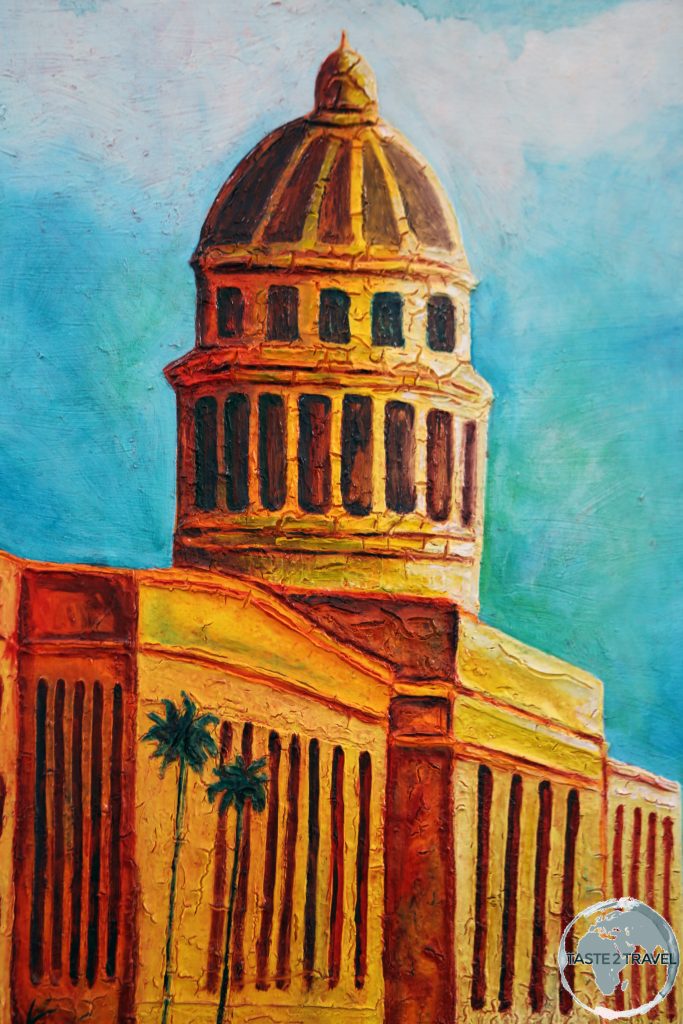
A painting depicting El Capitolio, the national Capitol building in Havana.
Cuba is an independent socialist republic, which is constitutionally defined as a “socialist state guided by the principles of José Martí, and the political ideas of Marx, Engels and Lenin.” The present Constitution also ascribes the role of the Communist Party of Cuba to be the “leading force of society and of the state.”
Executive power is exercised by the Government, which is represented by the Council of State and the Council of Ministers. Legislative power is exercised through the unicameral National Assembly of People’s Power, which is constituted as the maximum authority of the state.

Locals, lining up to buy orange soda, which had just arrived at a shop in downtown Sancti Spiritus.
Apart from the Communist party, there are no legally recognized political parties in Cuba. The communist party controls all aspects of life in Cuba, including almost 100% of the economy.
Among the most conspicuous of socialism’s failings is its capacity to generate vast shortages of things essential for life. This is a universal feature of a socialist “economy,” and it always has been, from the former Soviet Union to China, North Korea and Eastern Europe.
Likewise, in Cuba, food shortages, long lines outside grocery stores, and a complete lack of choice once inside the store, are part of daily life.
While I was walking through the old town of Sancti Spiritus, a buzz was created outside one grocery store when it was revealed that a pallet of Cuba’s version of Fanta had been delivered. Locals lined-up around the corner, waiting for their chance to purchase as many bottles as possible.
Currently Raúl Castro — brother of former President Fidel Castro — is President of the Council of State, President of the Council of Ministers, First Secretary of the Communist Party, and Commander-in-Chief of the Revolutionary Armed Forces.
Currency

Che Guevara adorns this 3-peso bank note, which I purchased from a currency dealer on Plaza de Armas in Havana old town.
The currency of Cuba is the Peso, with two different Peso’s currently in circulation – the CUC and the CUP. The CUC is a convertible peso used by tourists while the CUP is the national peso (moneda nacional) used by Cubans. The exchange rate between the two is fixed at 1 CUC = 25 CUP, while USD $1 = 1 CUC.
Most Cuban state workers receive their wages in national pesos and, with an average salary of US$20 per month, prices in CUP are generally very reasonable.
Shops which sell everyday products to Cubans only accept payment in CUP while imported ‘luxuries’ or foreign branded products are sold in “Dollar shops” in CUC. Anything sold to tourist’s is priced in CUC.
Internet

Internet surfing at Plaza José Martí in downtown Cienfuegos.
There’s no better place to be offline than Cuba, where internet is restricted, expensive and tediously slow.
To access the web, you first need to purchase a scratch-off ‘NAUTA‘ card from any office of the national telecom’s provider – Etesca. Cards cost CUC 2 and are valid for one hour of access, with customers able to purchase up to three cards at a time.
Etesca branches are famous for their long, snaking, slow queues. If you are faced with a long wait, you can try to purchase cards from touts who sell them for a small profit at the local WiFi spot or alternately, you can ask at the reception desk of larger hotels.

With almost two million Cubans living in the United States, Wi-Fi spots throughout the country, such as this one at Plaza Jose Marti in Cienfuegos, are always busy with families keeping in touch.
Once you have your card you need to locate the nearest WiFi spot, which is normally in the main square of each town and is easily found due to the ever-present hoard of locals gathered around using their smartphones to message/ call relatives overseas.
Etesca maintain a nationwide directory of 508 WiFi spots on their website.
Rum

Havana Club is Cuba’s most popular rum export.
As beer is to the Germans, wine to the French and a good cup of tea to the British – so Rum is to the Cubans. Along with cigars, rum is a core part of Cuba’s national identity.
You couldn’t visit Havana without visiting the Museo del Ron Havana Club (Havana Club Rum museum). Located in Havana old town, the museum includes displays which outline the history and production of rum in Cuba.
History
Rum is made from sugarcane, a crop that the Spanish introduced to the Americas after Columbus’ discovery in 1492. The first rum was produced on the Caribbean island of Barbados during the 17th century when plantation slaves discovered that molasses, a by-product of the sugar refining process, could be fermented into alcohol.
This was a good development since a pound of molasses (then treated as a waste product) was produced for every two pounds of sugar – islands which were awash in this sticky goo now had a profitable use for it!

The best place to buy cigars and rum in Cienfuegos is the “Casa del Habano – El Embajador‘”.
As refining techniques improved and the world acquired a taste for rum, other sugar-producing islands developed their own rum distilleries – including Cuba, which was a Spanish colony at the time. Cuba’s fertile soil and sticky climate proved ideal for growing many agricultural products including sugarcane.
While English colonies in the Caribbean produced bolder, darker rums and French colonies produced agricultural rums (rhum agricole), which retained more of the flavour from the sugar cane, Spanish colonies traditionally produced añejo (‘vintage’ or ‘aged’) rums, which are characterised by a smoother, more subtle taste. The tradition of añejo rums is all due to a request from the Spanish Crown for spirits which were more delicate in flavour.
By the late 1800’s, there were two major rum-distilling families in Cuba: the Bacardi’s and the Arechabala’s (who founded Havana Club). In 1960, following the Cuban revolution, Fidel Castro’s regime “nationalised” all Cuban companies, including these families’ distilleries.
This forced the families into exile, with the Bacardi’s fleeing to Puerto Rico. The family had anticipated the nationalisation move and had already moved their intellectual property, and most importantly, their valuable yeast strain out of Cuba.
Despite its exile, visitors to Cuba can today visit the former Bacardi headquarters in Havana, the very ornate, art deco – Edificio Bacardi (Bacardi Building) – which offers panoramic views of the old town from its rooftop. In Santiago de Cuba, you can view the original Bacardi factory from the street.
The Arechabala family, who had not anticipated the nationalisation program, and hence were not able to start up production outside of Cuba, fled to the United States.
Today Havana Club is produced in Cuba and sold globally (except the United States) through a joint venture between the Cuban government and Pernod Ricard.
A Quaffable Trio

The three most popular Cuban cocktails are all rum-based.
Three of the world’s most popular rum cocktails were born in Cuba – the Mojito, Cuba Libre and the Daiquiri.
Mojito

The national cocktail of Cuba, the Mojito, served at the Bacardi Rum museum in Santiago de Cuba.
Available at worthwhile bars around the world (and one of my favourite drinks) – the Mojito was originally born in Havana although its exact origin is subject to debate.
One story claims the drink was developed in the 1500’s when the famed English privateer – Sir Francis Drake – landed in Havana in order to sack the city of its gold.
While the invasion was unsuccessful, an associate of Drake created an early version of the Mojito, which he named El Draque, using rum, sugar, lime and mint.
Mojito’s have always been a popular drink and have been immortalised in popular culture, including in 2002 in the James Bond film Die Another Day.
Mojito Recipe
Ingredients
2 oz. white rum
1/2 oz. of freshly squeezed lime juice
1 teaspoon of superfine sugar
3 mint leaves
Soda water
Collins glass (tall glass)
Directions
1. In a Collins glass – mash the lime juice with the sugar.
2. Add the mint leaves, mushing them against the side of the glass.
3. Fill the glass 2/3 with ice then pour in the rum and stir gently.
4. Add the squeezed-out lime wedges and top off with soda water.
Cuba Libre
A simple mix of rum, coke and lime juice served on ice, the “Cuba Libre” (Free Cuba) originated in Cuba in the early 20th century after the country won its independence from Spain.
American soldiers, celebrating victory after the Spanish-American War, requested their Coca-Cola be mixed with Cuban rum. They toasted to a free Cuba, thereby creating the original Cuba Libre which is today one of the world’s most popular alcoholic drinks.
Daiquiri
The word Daiquiri comes from the Taino (native Indian) language and is the name of a village located a short distance from Santiago de Cuba.
During the early 20th century, an American mine engineer – Jennings Cox – was working at an Iron mine near to Daiquiri when he ran out of gin while entertaining American guests. He instead served local rum but added lime juice and sugar to improve the rum’s taste. The Daiquiri – one of the world’s most popular cocktails – was born!
Cigars

Montecristo Cigars, on sale at the factory shop in Havana (CUC5.55 = USD$5.55).
History
The origins of cigar smoking are unknown, but what is known is that people have enjoyed smoking them for centuries. Depictions of Mayan Indians smoking cigars can be found on pottery-ware dating back a thousand years. It’s possible the word Cigar is derived from the Mayan word for smoking – Sikar.
What is known is that Christopher Columbus and his men encountered tobacco for the first time in 1492 on the island of Hispaniola (present day Haiti and Dominican Republic – click links to read my reports for these destinations) when natives presented them with some dried leaves.
At the time of Columbus’ arrival, tobacco plants were widely diffused among all of the islands of the Caribbean, including on Cuba, where Columbus settled with his men. The word cohíba (today a famous brand of Cuban cigar) derives from the native Taino word for ‘tobacco‘.

Cigars are integral to the Cuban identity.
In time, European sailors in the Caribbean acquired a taste for tobacco which later became popular in Europe and the rest is history.
As the demand for tobacco increased, farms were established in the Caribbean with the first commercial farm being created by the Spanish on Cuba in 1542. In 1592, a Spanish galleon carried 50 kilograms (110 lb) of tobacco seed to the Philippines (then the Spanish East-Indies), marking the introduction of the crop into Asia.
As with sugarcane, the soil and climate of Cuba proved ideal for growing tobacco. Initially the most popular export from Cuba was sugar, however, as tobacco’s popularity increased, the export percentages switched and tobacco became the number one export out of Cuba.

The Cohíba brand was created by Fidel Castro with cigars supplied to party elites and foreign dignitaries.
Cigar Production
Today, tobacco is Cuba’s 3rd largest export item with the western-most province of Pinar del Rio being the principle growing region. Famous Cuban cigar brands include Cohíba, Montecristo, Partagás, Romeo Y Julieta and Bolivar.

An advertisement for Romeo y Julieta cigars in Havana.
The Cohíba brand was created by Fidel Castro as a superior brand of cigar to be enjoyed by party elites. The cigars proved popular and were soon being presented to foreign dignitaries and statesmen as gifts.
The cigars were then made available to the public during the 1982 Football World cup in Spain and have been on the market ever since, available everywhere – except the United States.
Habanos S.A. – an arm of the Cuban state tobacco company, controls the promotion, distribution, and export of Cuban cigars worldwide.
Classic American Cars in Cuba

There are lots of classic American cars to be found on the streets of Cuba, such as this red beauty in Havana old town.
Prior to the revolution in 1959, most cars imported into Cuba were manufactured in the United States. American cars were imported into Cuba for about 50 years, beginning near the early 20th century.
After the Cuban Revolution, the U.S. embargo was enacted by the US congress, and, to spite the US, Fidel Castro banned the importation of American cars and mechanical parts.
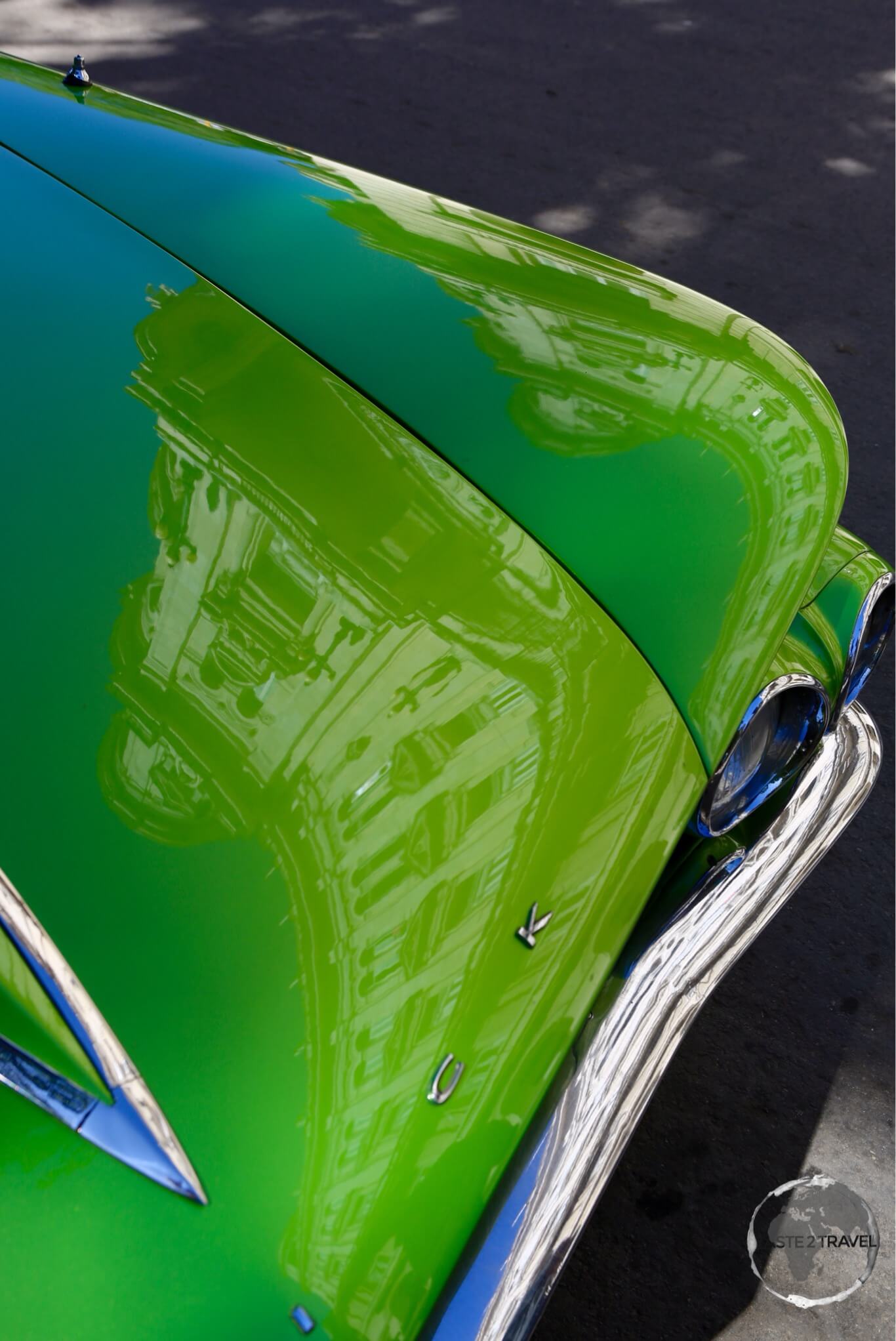
An ornate building in Havana old town is reflected off the polish hood of a Buick.
With little car imports, little choice and now meagre salaries, Cubans who owned these American classics were forced to keep them in good working order using whatever parts they could.

The interior of an American classic car in Havana old town.
Currently, it’s estimated that there are around 60,000 classic American cars in Cuba, with 50% of those cars hailing from the 1950s, and 25% each from the 1940s and 1930s. I once rode in a taxi in Holguin which was manufactured in 1948!
Spend any time travelling in Cuba and you’ll find yourself riding in an array of auto relics from a bygone era.

A hood ornament on a classic American car in Havana old town.
Since the embargo prohibits the importation of parts from the United States, these classic cars have been kept on the road using Cuban ingenuity, with many cars fitted with Russian parts, including Soviet-era engines.
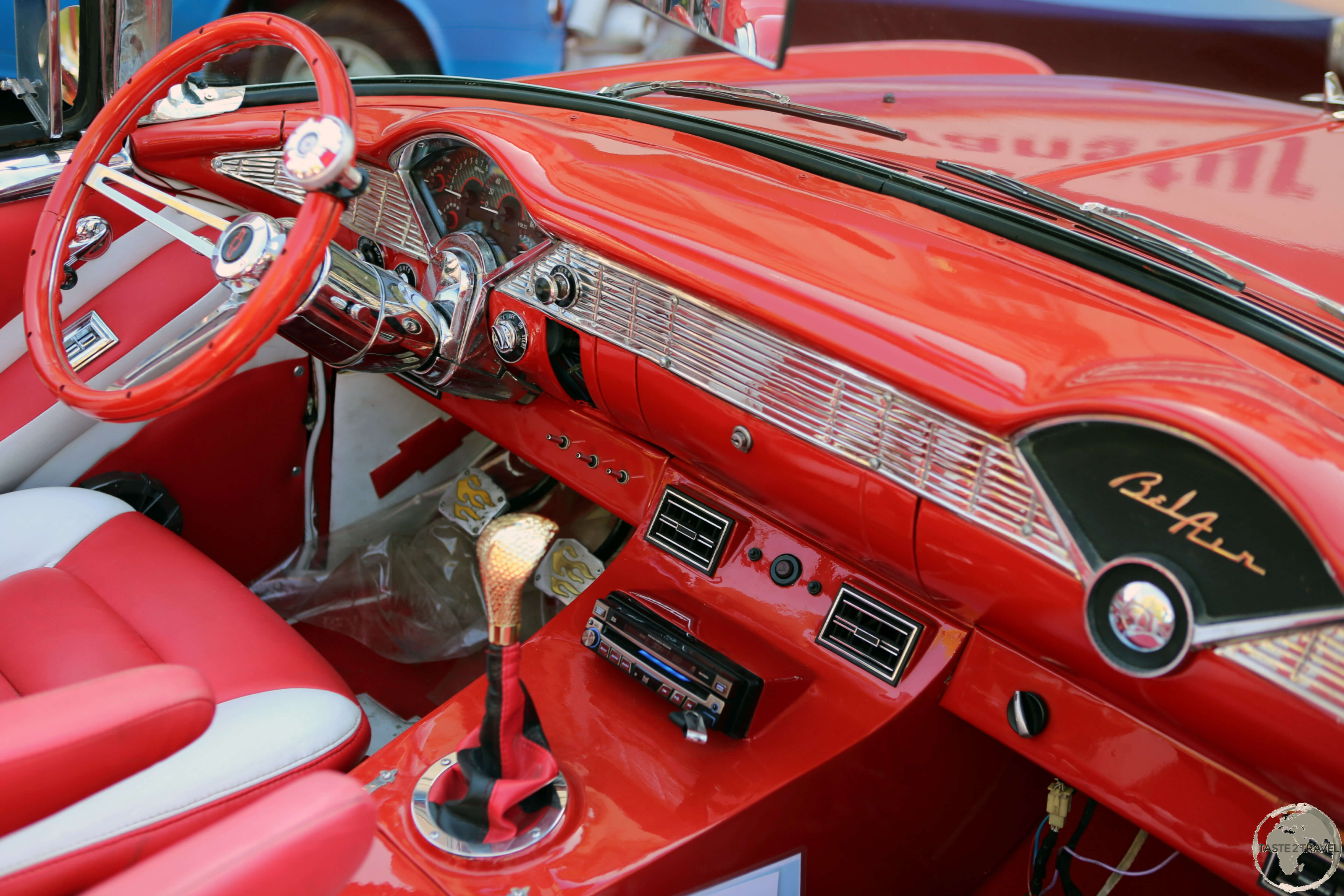
An immaculately maintained Bel-Air classic-car taxi in Havana.
Since the revolution, most cars imported into Cuba have been Russian-made Ladas. More recently, Chinese models such as Geelys have become popular.
With the government controlling the car market, and setting astronomically high prices for new cars, the survival of American classic cars in Cuba is assured.
Havana Classic Cars Taxi Tours

Pick your colour! American classic car taxi’s available for hire at Parque Central in Havana old town.
Visitors to Cuba can take driving tours in classic American cars, especially in Havana old town where drivers congregate on one side of Parque Central, opposite the Hotel Inglaterra.

Interior view of an American classic car taxi in Havana old town.
Many of the taxis are convertibles, which are perfect for cruising the streets and taking photos. Taxi tours cost around 25 CUC (US$25) per hour and can be pre-booked here.

American classic car taxi’s available for hire at Parque Central in Havana old town.

Beautifully maintained American classic car taxis at Parque Central in Havana old town.
Sightseeing

A florist in Havana old town.
With 70% of its population living in cities, Cuba is a largely urban nation, with most cities comprised of a colonial old town at their core.
The post-revolution (1959) years have been characterised by a distinct lack of development, leaving most of these cities as charming time capsules. During my time on the island, I explored seven of these enchanting cities which are described in this section.
Havana
Havana Old Town

A treasure trove of Spanish-era colonial architecture, Plaza Vieja, in Havana old town, dates from 1559.
Havana (Spanish: La Habana), is the throbbing heart of Cuba. It’s the capital city, largest city (population: 2.1 million), main aviation and maritime hub and leading commercial centre. At its heart, the charming Habana Vieja (Havana old town) is the main tourist draw.

A view of Plaza Vieja in Havana old town, which is home to a lively craft beer bar and non-stop salsa music.
With a history stretching back 500 years, the old town is brimming with Spanish-colonial architecture and, after 50 years of neglect, is slowly, and carefully, being renovated.

Havana old town has suffered through 50 years of post-revolution neglect but is slowly being renovated.
Walking the streets of the enchanting old town, you can feel the history around you.
Plaza de la Catedral

The historic Havana Cathedral is located on Plaza de Catedral in Havana old town.
Havana old town is comprised of numerous grand squares, which can best be described as jewels of colonial architecture. The Plaza de la Catedral is anchored by the ornate Havana Cathedral.

There’s no shortage of opulent interiors in Havana old town.
Experimental Graphics Workshop

An artist preparing his next masterpiece at the Taller Experimental de Grafica in Havana old town.
Located at the end of a short cul-de-sac, around the corner from Havana cathedral, the Taller Experimental de Grafica is one of Havana’s most cutting-edge art workshops. Local artists create abstract works of art using old-time printing presses.
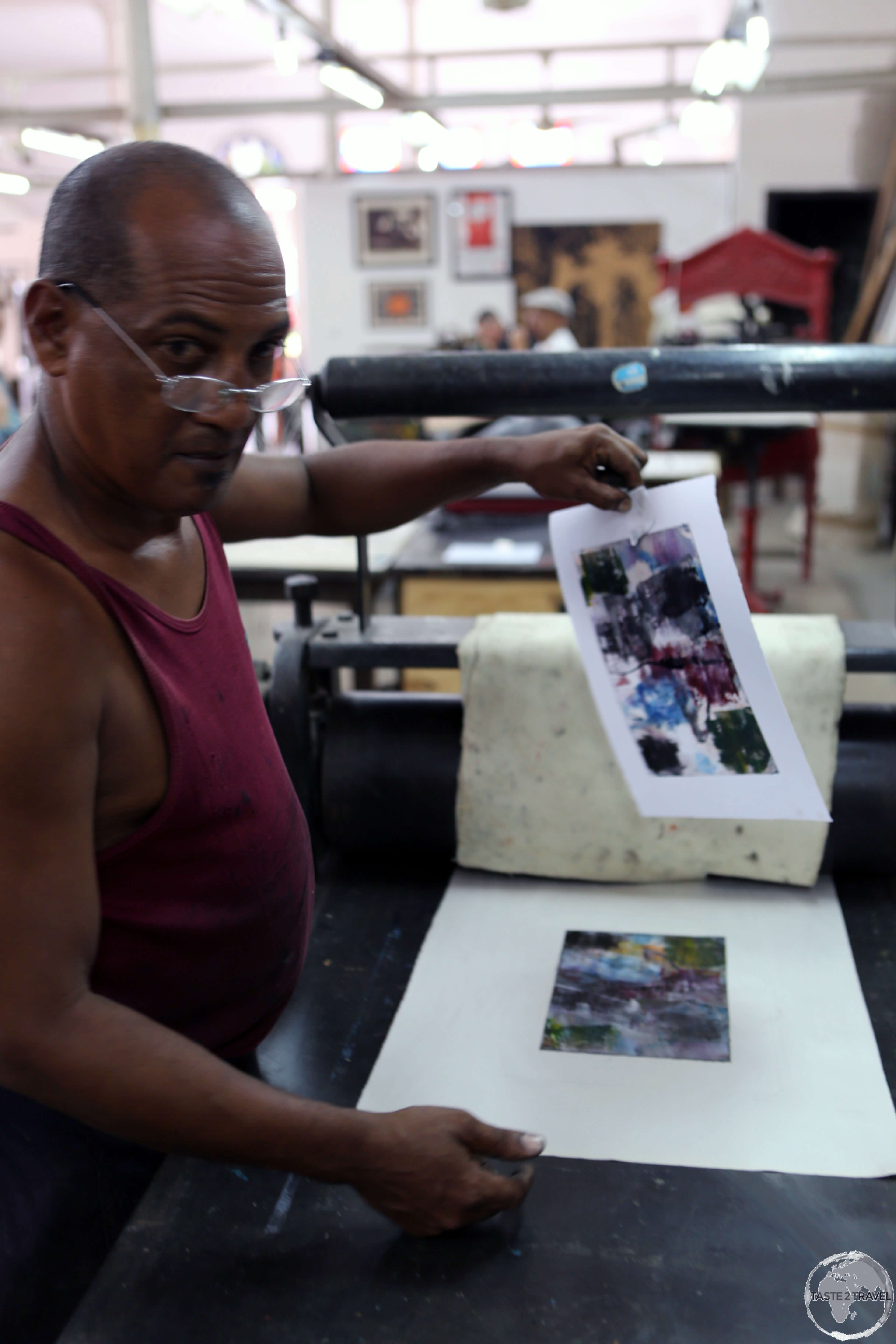
A newly pressed piece of art (which I purchased) at the Taller Experimental de Grafica in Havana old town.
Artworks can be purchased and art glasses can be arranged in advance.
Plaza de Armas
Of the many squares in Havana old town, the main square, Plaza de Armas, is flanked by historic buildings and museums and is always alive with musicians, booksellers and arts and crafts vendors.

The façade of the historic Hotel Santa Isabel which lies on the Plaza des Armas in the heart of Havana old town.
On the eastern side Plaza de Armas is the Palacio De Los Capitanes Generales which is the former official residence of the Governors of Havana. The Palace today houses the Museo de la Ciudad (Museum of the City of Havana).
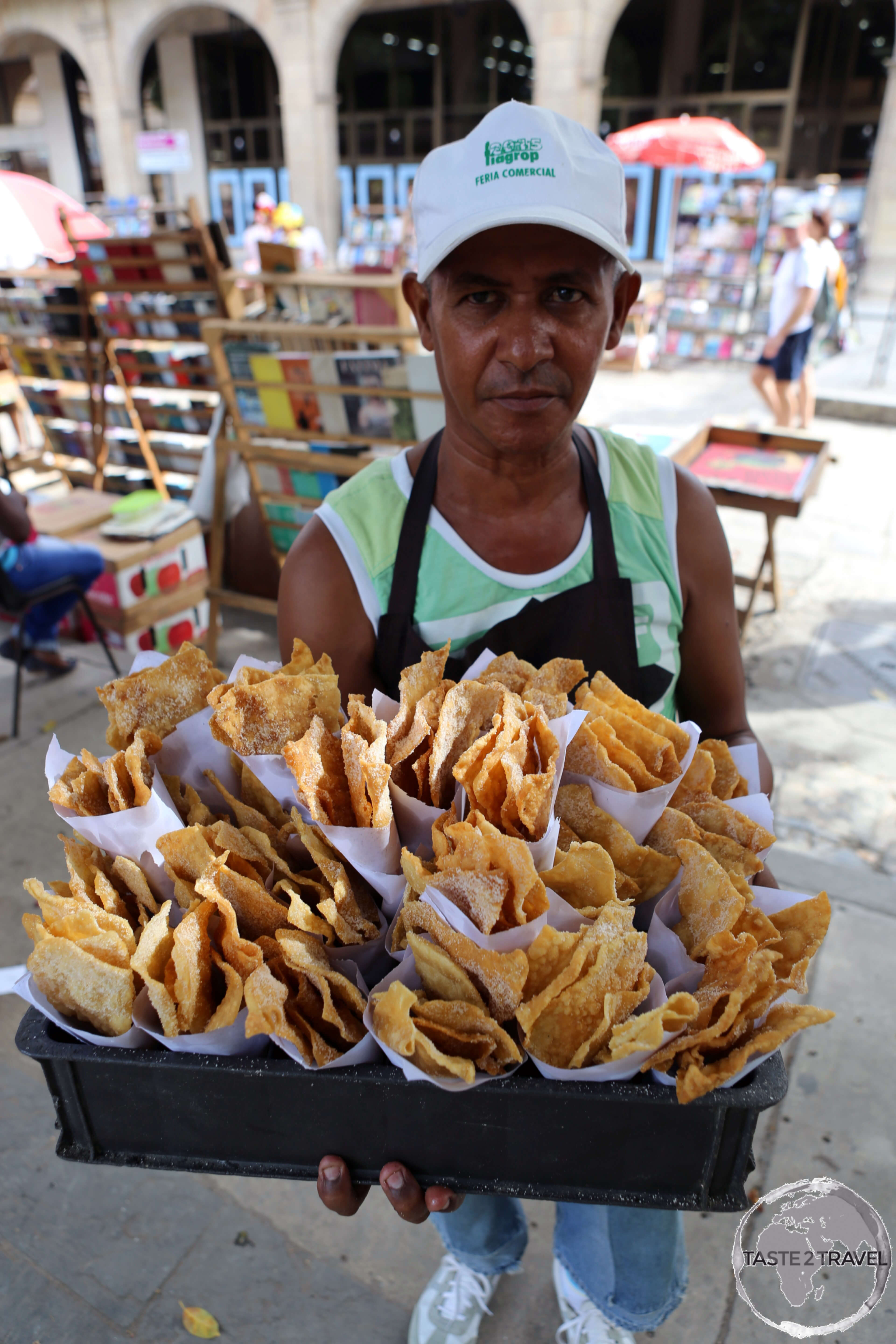
A snack vendor on the Plaza de Armas in Havana old town.
Lining the squares are cathedrals, old mansions which have been converted into museums, galleries, shop’s, restaurant’s, cafe’s, bar’s, and always – music. The music never stops in the old town, there’s always a band playing somewhere and there are lots of venues where you can dance salsa through the night.

Souvenir sellers can be found peddling old Cuban stamps and Cuban currency on Plaza de Armas.
Ernest Hemingway

A plaque outside room #511 at Hotel Ambos Mundos which Hemingway occupied from 1932 to 1939.
If you’re a Hemingway fan, you can visit his former room at the Hotel Ambos Mundos which is located on Plaza de Armas.

Ernest Hemingway’s room at the Hotel Ambos Mundos in Havana old town.
The legendary author rented room #511 from 1932 to 1939 for the cost of US$1.50 per night. During his time here, we wrote For Whom the Bells Toll. Today, his hotel room is presented as if the author might have left it.
Museo de la Revolución

The sweeping dome inside the Museo de la Revolución in Havana old town.
Of the many museums in the city, the Museo de la Revolución (Museum of the Revolution) is the one place where you can gain an understanding of the events which led to the Cuban revolution and the rise of the cult of Fidel Castro.
This museum is set in the former Presidential Palace, constructed between 1913 and 1920 and used by a string of Cuban presidents, culminating in Fulgencio Batista.
Museo Nacional de Bellas Artes

Symbolic artwork, with Cuba defeating the USA in a boxing match, at the Museo Nacional de Bellas Artes in Havana.
Next door, the Museo Nacional de Bellas Artes (National Museum of Fine Arts) provides a comprehensive display of Cuban art – both old and contemporary.
Parque Central

A statue of José Martí in Parque Central with the Hotel Inglaterra in the background.
Also, in the old town, Parque Central features a monument to the Cuban national hero – José Martí.
The ever-lively, full-of-old-world-charm Hotel Inglaterra (see the ‘Accommodation‘ section below) overlooks the park and is a great place to relax with a Mojito and listen to some live music. If you wish to hire an old-timer taxi to explore Havana, you’ll find the drivers at one end of the park.

Soldiers visiting a statue of José Martí in Parque Central in Havana.
El Capitolio

The domed El Capitolio building in Havana serves as the nation’s capital building.
The El Capitolio is Havana’s most ambitious and grandiose building. Funded by the proceeds of huge sums of money made from sugar exports, the Cuban capitol is similar in design to the Capitol building in Washington, DC – but is actually modelled on the Panthéon in Paris.

El Capitolio, the National Capitol building in Havana.
The building was initiated by Cuba’s US-backed dictator Gerardo Machado in 1926 and took 5000 workers three years, two months and 20 days to construct, at a cost of US$17 million. Formerly the seat of the Cuban Congress, following the revolution, it housed the Cuban Academy of Sciences and the National Library of Science and Technology.
Edificio Bacardi

Edificio Bacardi, the former headquarters of the Bacardi Rum company in Havana.
Panoramic views of the chaotic, crumbling, urban jumble that is Havana old town are available from the rooftop of the Edificio Bacardi, the former Havana headquarters of the Bacardi Rum corporation.

A view of the Havana old town from the rooftop of Edificio Bacardi.
Located on the corner of Calles Monserrate and San Juan de Dios, Edificio Bacardi is an Art Deco landmark, which was completed in 1930.
The Malecón

The sculpture, Primavera, was installed on the Malecón in 2015 as part of the 12th Biennale.
The Malecón is Havana’s 7km-long sea drive which runs along the seashore from Havana harbour into the suburbs. Laid out in the early 1900s as an oceanside boulevard for Havana’s pleasure-seeking middle classes, the Malecón is lined with grand buildings in a mix of architectural styles, many of which have succumbed to the corrosive elements after years of post-revolution neglect.
One of the highlights of the Malecón is the 26-ft high sculpture, Primavera (‘spring’), which was designed by Cuban sculptor Rafael San Juan and celebrates the spirit of Cuban women.
Morro Castle
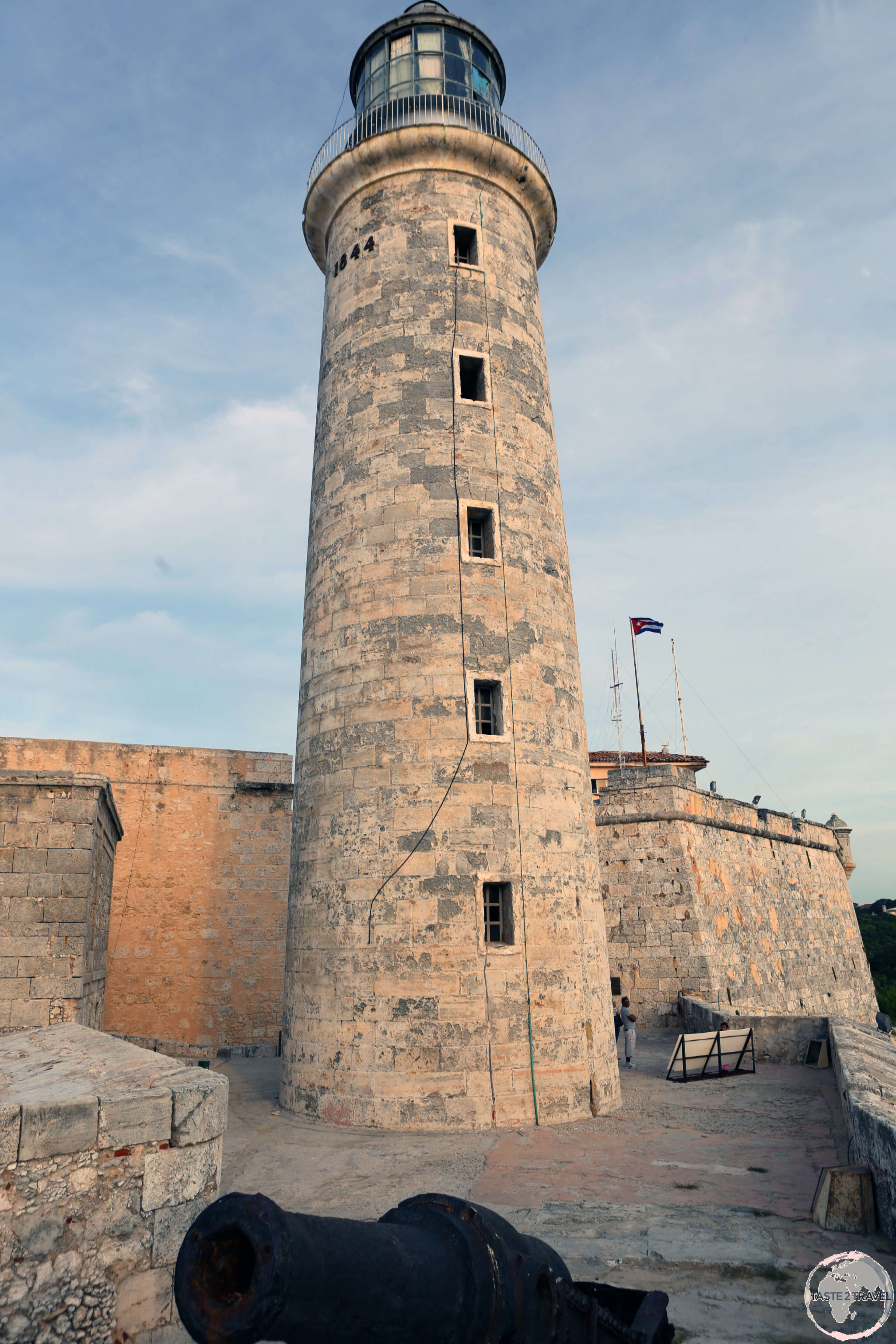
This lighthouse which stands at the entrance to Havana harbour is part of the Castle Morro complex.
Outside the old town are a couple of imposing coastal fortifications (San Salvador de la Punta Fortress on the city side of the bay and Morro Castle on the opposite shore), which guard the entrance to the all-important harbour.

View of Havana harbour from Morro Castle.
Cristo de La Habana

Overlooking Havana bay, the 20-m high, 350-ton, Cristo de La Habana is carved from Italian Carrara marble.
Located near Morro castle, Cristo de La Habana (The Christ of Havana) is a large sculpture representing Jesus of Nazareth on a hilltop overlooking Havana harbour. The statue is the work of the Cuban sculptor Jilma Madera, who won the commission for it in 1953.
Cienfuegos
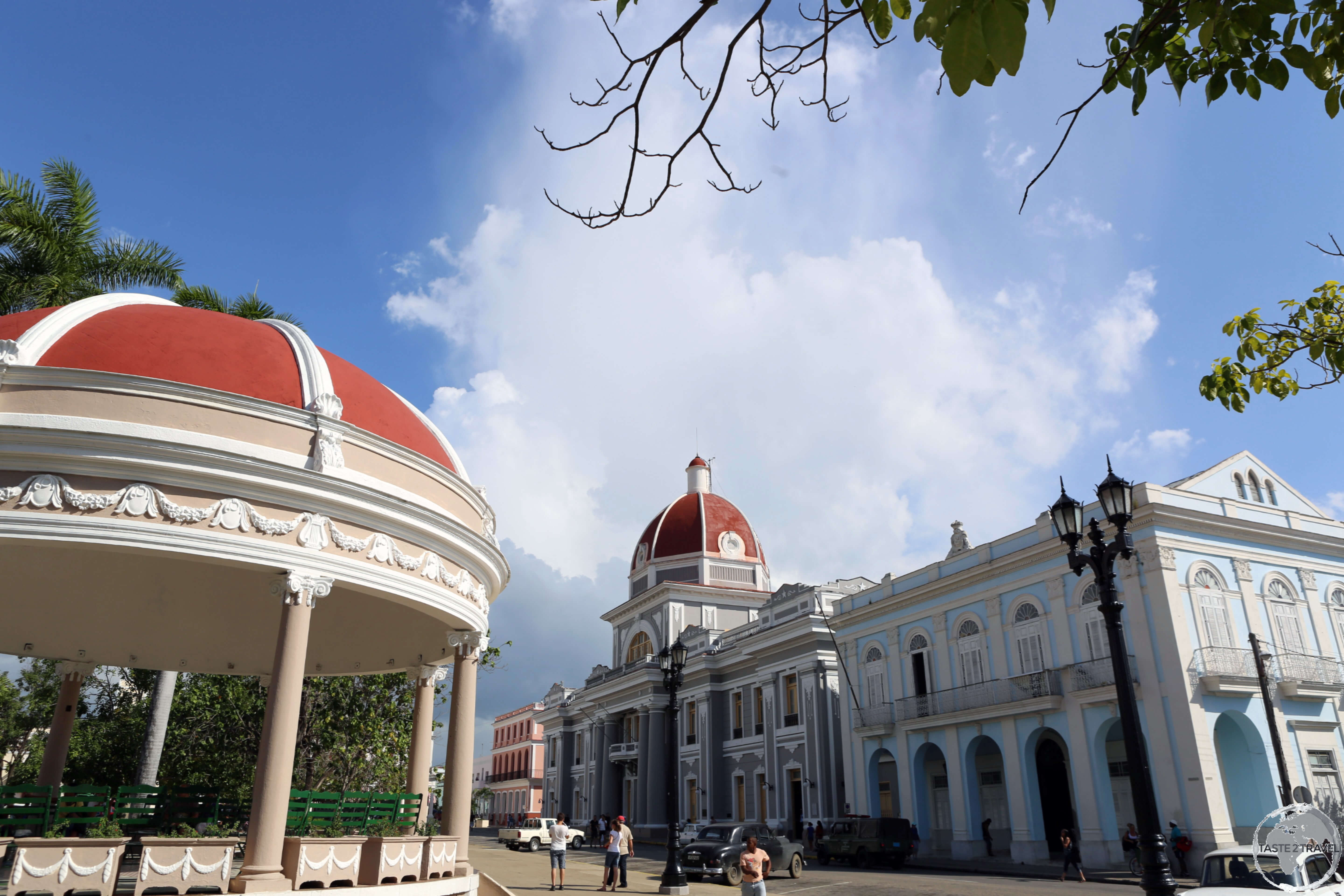
A view from Plaza José Martí, the heart of Cienfuegos, with the red dome of the imposing Palacio de Gobierno (home to the Museo Provincial) in the background.
Situated on the Caribbean coast of southern-central Cuba, at the heart of the country’s sugar cane, mango, tobacco and coffee production area, delightful Cienfuegos (English: Hundred fires) was founded by French settlers escaping the revolution in neighbouring Haiti (click to read my Haiti Travel Guide).
The French established themselves as agricultural barons and used their wealth to construct fantastic mansions in the neoclassical style, which today makes Cienfuegos a pleasure to explore.
Plaza José Martí

A proud dog owner relaxing in Plaza José Martí in Cienfuegos.
At the centre of the old town is the attractive, and always-animated, main square – Plaza José Martí. If you’re searching for a Wi-Fi hot-spot in the city, you’ll find it here – just look for the crowd of Cubans on their smartphones.

A classic American car alongside the Arco de Triunfo (Arch of Triumph) at Plaza José Martí in Cienfuegos.
Around the square are a collection of sights worth visiting, including the Museo Provincial, Teatro Terry and the iconic Museo de las Artes Palacio Ferrer which is housed in an impressive neo-classical mansion. Within the plaza, the Arco de Triunfo (Arch of Triumph) and red-roofed rotunda are notable features.
Teatro Terry
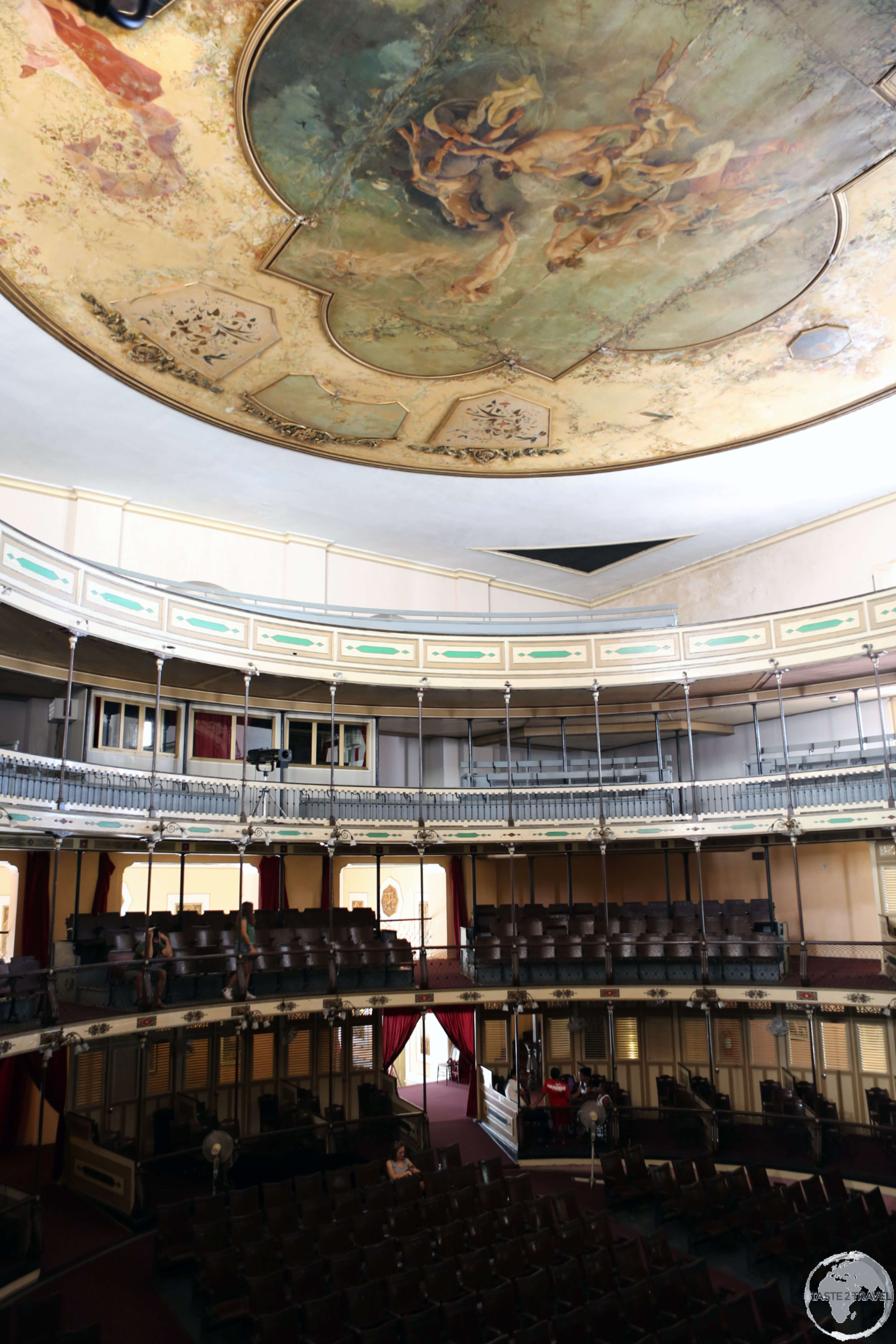
The interior of the Teatro Terry in Cienfuegos, which overlooks Plaza José Martí.
Located on the northern side of Plaza José Martí, the Teatro Terry was built between 1887 and 1889 to honour Venezuelan industrialist Tomás Terry. Listed as a national monument, this spectacular 950-seat auditorium is decorated with Italian marble, hand-carved Cuban hardwood floors and Classicist-style ceiling frescoes.
Performances at Teatro Terry are held most evenings with tickets costing a few CUC. The theatre bar occupies a shady courtyard and is a good place to enjoy a Mojito.
Palacio de Ferrer

The neoclassical Palacio Ferrer, with its iconic cupola, overlooks Plaza Jose Marti in downtown Cienfuegos.
On the western side of Plaza José Martí is the iconic, pastel-blue, former Palacio de Ferrer (1918), which was built by the merchant and landowner José Ferrer in the neoclassical style.
Today home to the Museo de las Artes Palacio Ferrer, the standout feature of the Palace is the rooftop cupola, which overlooks the square. At the time of my visit, it was closed for renovations and seemed to have been closed for some time.

A music concert at El Louvre: Studio/ Café in Cienfuegos.
Located next door to Palacio Ferrer is the popular El Louvre: Studio/ Café which hosts occasional concerts.
Museo Provincial

Interior of the Museo Provincial in Cienfuegos.
On the southern side of the square is the rather lacklustre Museo Provincial, which is housed inside the municipal Palacio de Gobierno.
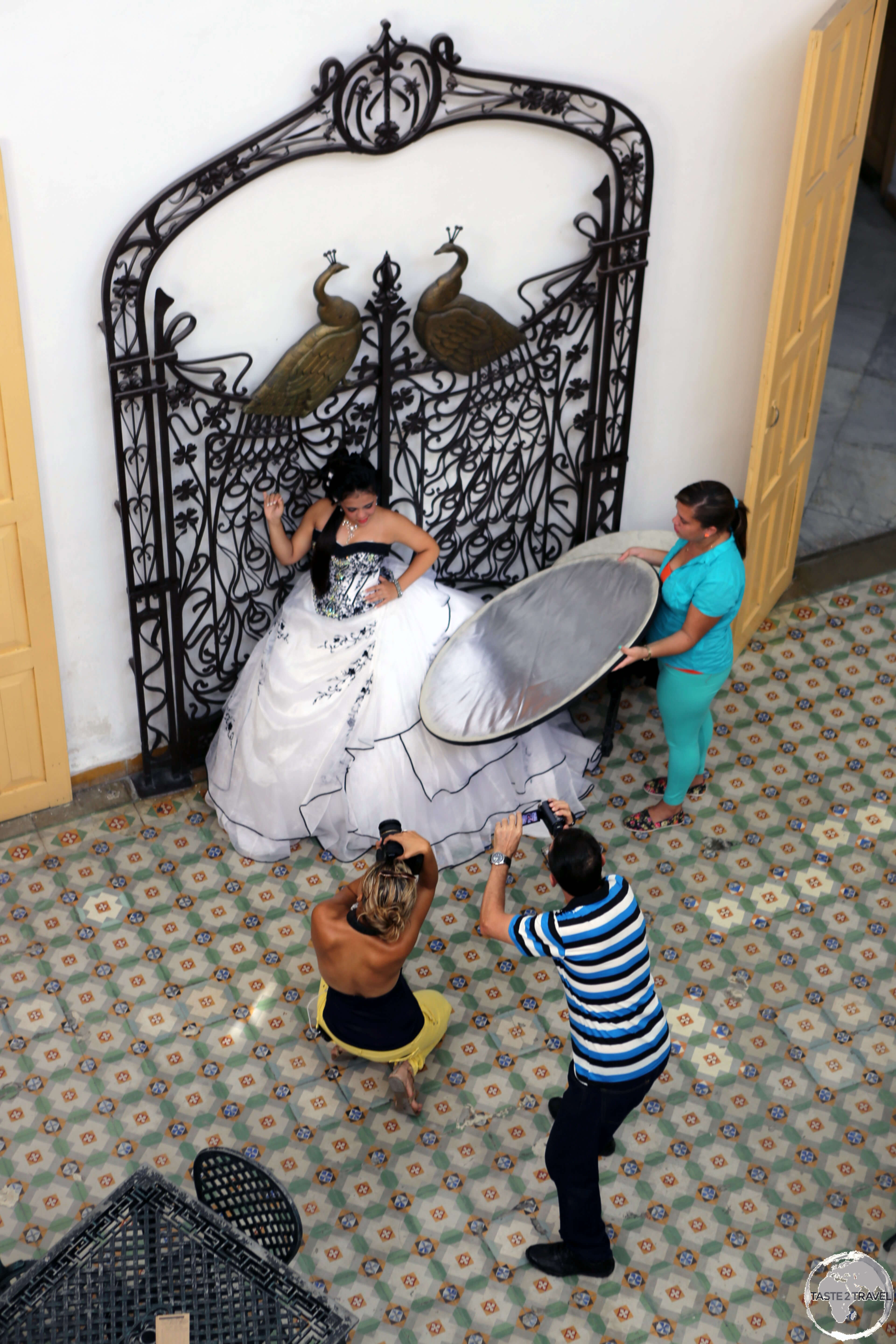
A bride being photographed inside the Museo Provincial in Cienfuegos.
This grand building, which was originally built by the Spanish as a casino, offers an overview of the history of Cienfuegos. Dusty displays include furnishings from 19th-century French-Cuban society. The elaborate interior forms a perfect backdrop for wedding photos and model shoots, which I witnessed during my visit.
Casa del Habano – El Embajador
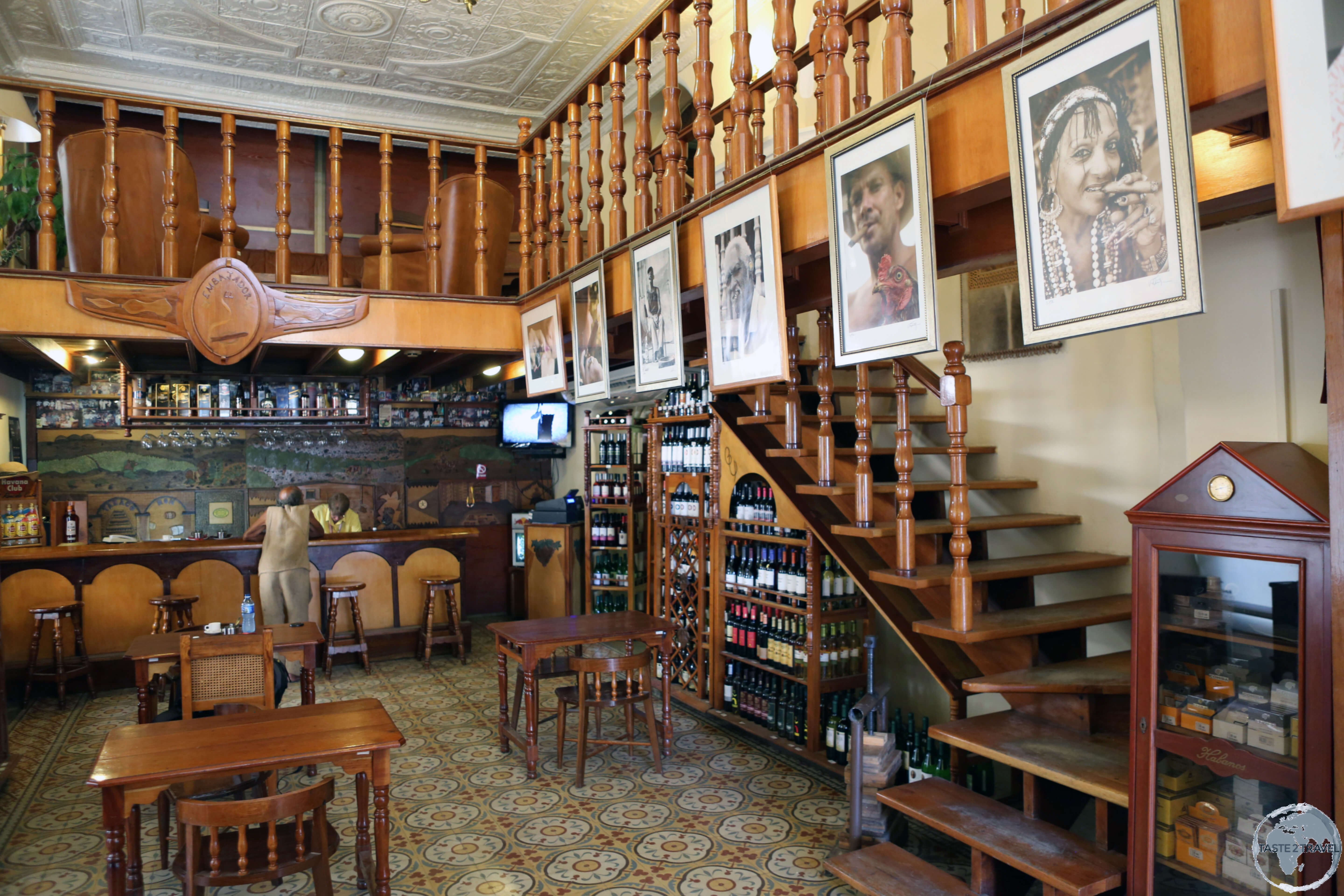
A great place to gain an appreciation of Cuban rum and cigars is at the wonderful “Casa del Habano El Embajador‘” in Cienfuegos.
While there are plenty of rum and cigar shops in Cuba, one of my favourites is the amazing emporium which is Casa del Habano – El Embajador, which is located downtown at Avenida 54, between Calles 33 and 35.

A view of the most amazing rum and cigar emporium – the “Casa del Habano El Embajador” in downtown Cienfuegos.
Among the haze from puffing cigar aficionados, you’ll also find a large selection of Cuban rum and excellent coffee.
Paseo del Prado

One of many grand, French-built, neoclassical, mansions which line the main street of Cienfuegos – the Paseo del Prado.
South of the centre, the main street, Paseo del Prado, becomes the Malecón, which cuts alongside the beautiful, sweeping, natural bay.
The Malecón ends at the seaside neighbourhood of Punta Gorda, home to a yacht club, the biggest hotel in town (Hotel Jagua), restaurants, bars and nightclubs.
Palacio de Valle

The exterior of the Moorish-style Palacio de Valle in Cienfuegos.
Had enough of all the Neo-classical architecture in Cienfuegos? How about something Moorish?
One of the highlights of Punta Gorda is the Palacio de Valle. Originally built as a private villa by Italian architect, Alfredo Colli, from 1913 to 1917, the Moorish-style Palacio de Valle resembles an outrageously ornate Moroccan Casbah.

The incredibly opulent interior of the Palacio de Valle in Cienfuegos.
Originally intended to be a casino, the onset of the revolution put an end to those plans, and today the building houses a hotel and restaurant with an excellent rooftop terrace bar.
Trinidad

Colourful houses line the cobbled streets of Trinidad old town.
Located in the province of Sancti Spíritus in the heartland of Cuba, Trinidad (population: 74,000) is a perfectly preserved colonial jewel, which has been listed as a UNESCO World Heritage site since 1988.

Typical street scene in Trinidad old town.
The town was originally founded by Diego Velázquez de Cuéllar in 1514 and, in 1518, Hernán Cortés recruited men from the town for his expedition to Mexico.

A young boy in Trinidad old town.
The countryside surrounding Trinidad proved ideal for growing sugarcane and, at its peak in the early 19th century, there were 56 sugar mills in the region, with one of them producing a record cane haul one year that resulted in almost one million kilos of processed white sugar. The fortunes made from the sugar industry were spent building fine mansions, churches and plazas in Trinidad.

The colourful houses of the delightful old town of Trinidad.
The cobbled streets of the old town are full of museums, art galleries, cafes, restaurants and beautiful plazas. This is one place to put way your guidebook, meander, get lost and soak up the ambience.

Souvenir shop in Trinidad.
The town’s centre-piece is the tiny, but beautiful Plaza Mayor, which is surrounded by many fine colonial-era buildings and is dominated by the Iglesia Parroquial de la Santisima Trinidad.
The plaza is essentially an open-air museum of Spanish Colonial architecture, surrounded by a collection of beautiful houses painted in different pastel shades with wrought-iron grilles.

Artwork in Trinidad.
These old mansions today house museums, shops and restaurants. The plaza is also one of the Wi-Fi hotspot’s in Trinidad, with locals thronging to the square to talk to relatives in the US.
In the evening there’s lots of lively entertainment in and around the plaza with musicians, food vendors, performers and a string of bustling cafes and restaurants.

An art studio in Trinidad old town.
The best panoramic views over the old town are from the top of the tower at the Museo de Historia Municipal which is near to Plaza Mayor.

Museo de Historia Municipal in Trinidad old town.
The museum tells the story of the history of Trinidad but its main attraction is its tower, which you can climb (via several flights of rickety wooden stairs) for spectacular views over the old town.

The interior of the Museo de Historia Municipal in Trinidad.
Sancti Spíritus
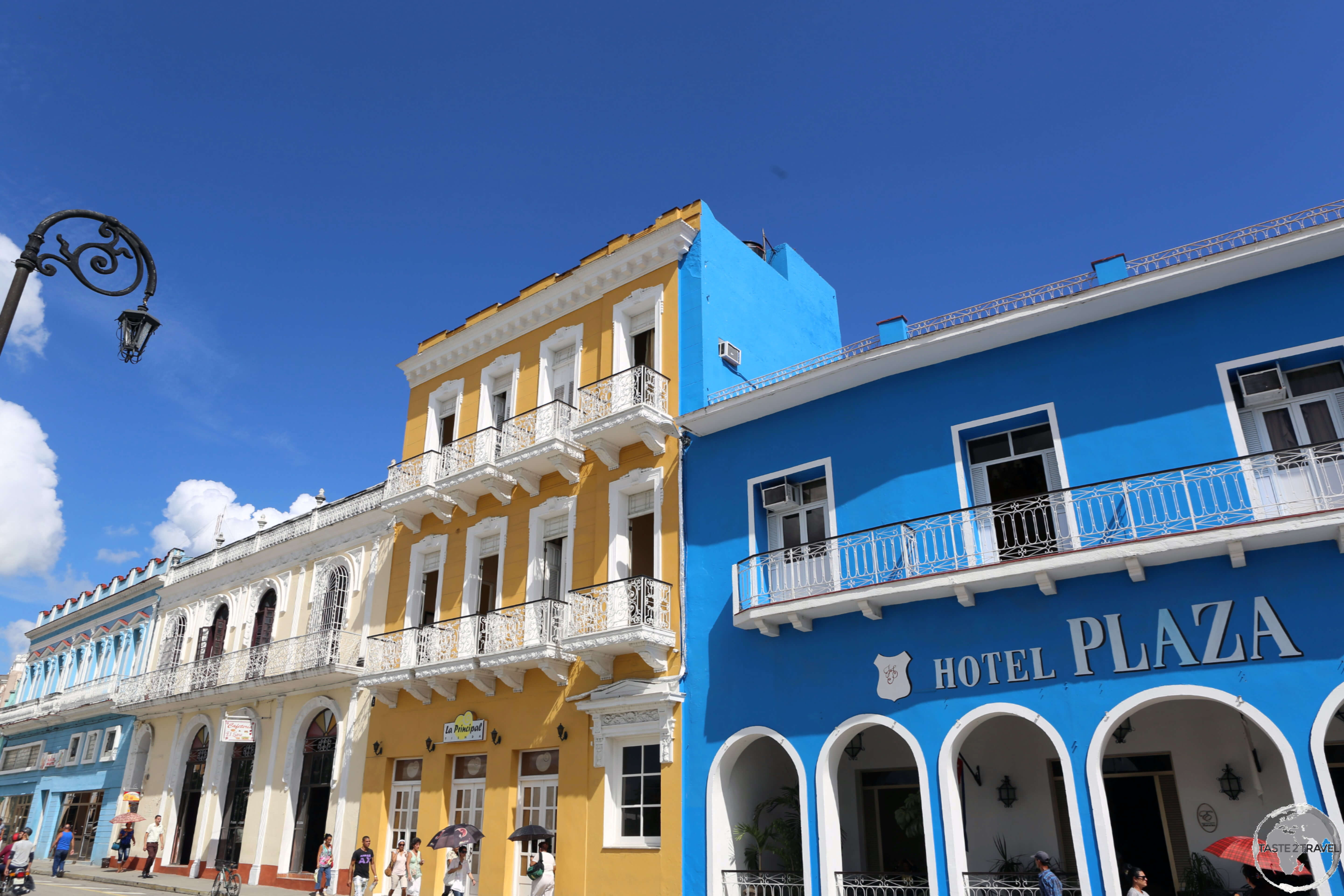
Parque Serafin Sanchez, the main square of Sancti Spíritus, is lined with beautiful Spanish, colonial-era, buildings.
The captivating city of Sancti Spíritus (population: 134,0000) is the capital of the province of the same name.

The streets of Sancti Spíritus old town are lined with colourful, colonial-era gems.
Like neighbouring Trinidad, the city was founded by Diego Velázquez de Cuéllar in 1514 and also contributed men for Hernán Cortés’ 1518 expedition to Mexico.

The historic Puente Yayabo spans the Yayabo river in downtown Sancti Spíritus.
Located on the River Yayabo, the city’s main landmark is the beautiful stone Puente Yayabo which spans the river. Built in 1815 from clay bricks, it forms five arcs, the centre arc being 9 metres tall. The bridge was designed and built for pedestrians and carriages but today is used for vehicular traffic.

Cuba’s oldest church, the 16th century Parroquial Mayor in Sancti Spíritus.
Up the hill from the river is the city’s main site and Cuba’s oldest church – the Parroquial Mayor. This blue-towered church was built in the early 16th-century.

School children in Sancti Spíritus.
The old town is a pleasant place to stroll, with the picturesque main square – Parque Serafin Sanchez – being the perfect place to relax and breath in the history of the city.
Sancti Spíritus Cigar Factory

Workers at a cigar factory in the old town of Sancti Spíritus.
Located in the heart of the old town of Sancti Spíritus is an old cigar factory, which is staff almost exclusively by women, who spend their day toiling away, rolling fine Cuban cigars.
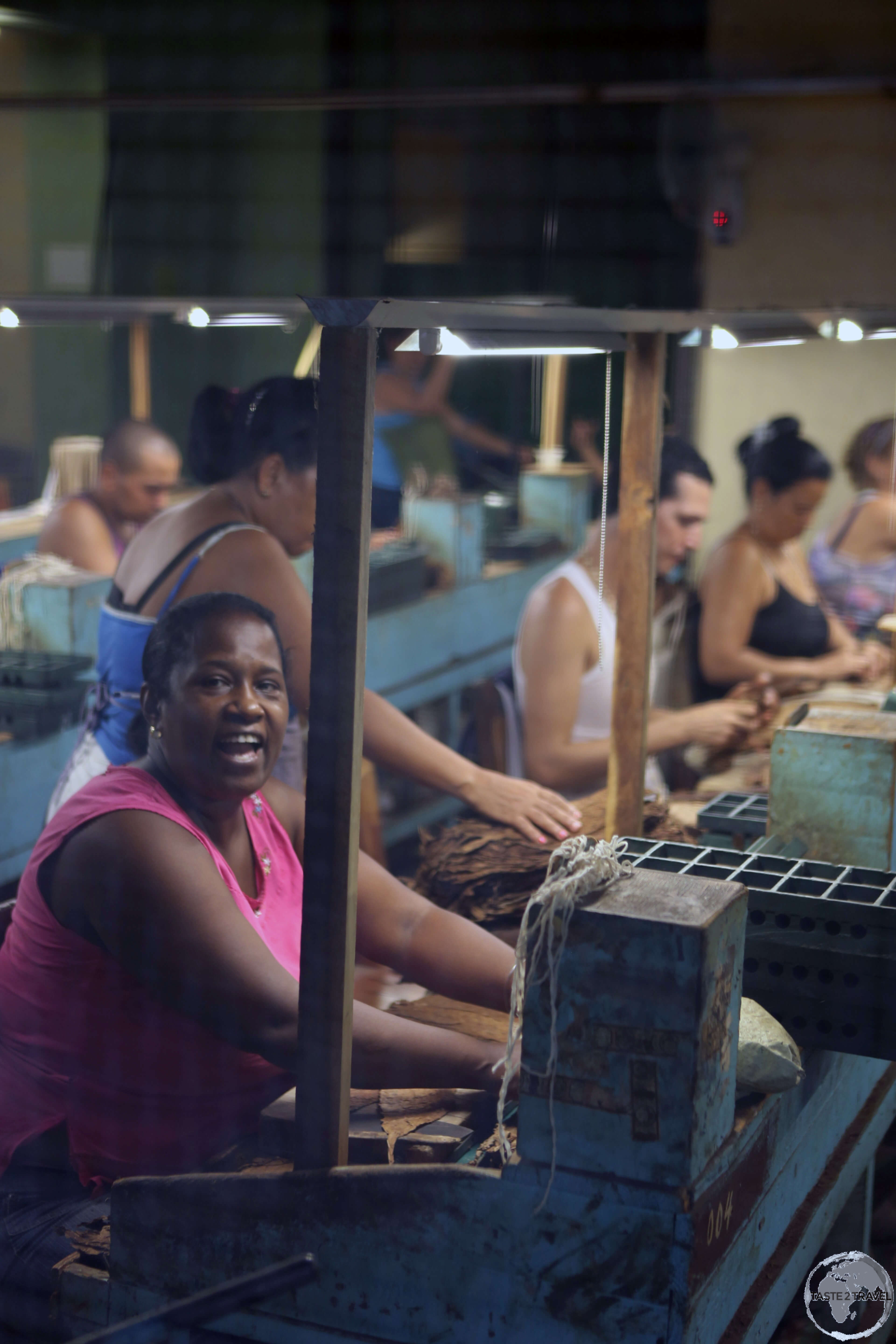
Cigar factory workers in Sancti Spiritus, where most of the workers are female.
While I was not allowed to enter the factory, the factory staff were all very curious and friendly and were happy for me to photograph them through the wired-meshed windows.

A worker in a cigar factory in Sancti Spíritus.

Rolling cigars in the Sancti Spíritus cigar factory.
Ciego De Avila
The sleepy city of Ciego de Avila (population: 136,0000) is the capital of the province of the same name. The city lies on the Carretera Central (central highway) so many people pass through it but few stop, with most visitors to the province heading to the beach resorts on the north coast at Cayo Coco.
The old town contains a nice collection of colonial-style buildings, which are arranged around the central Parque Martí. The park, which has a statue of José Martí at its core, was originally laid-out in 1877 in honour of then king of Spain, Alfonso XII, but was later renamed in honour of the Cuban national hero. The park is a great place to kick-back, watch the world go by and meet the locals.
A short walk from the park is the Museo Provincial Simon Reyes (look for the two white soldiers (statues) standing guard outside), which is a very fine provincial museum. Exhibits cover local history, Afro-Cuban culture and religion.
Camagüey
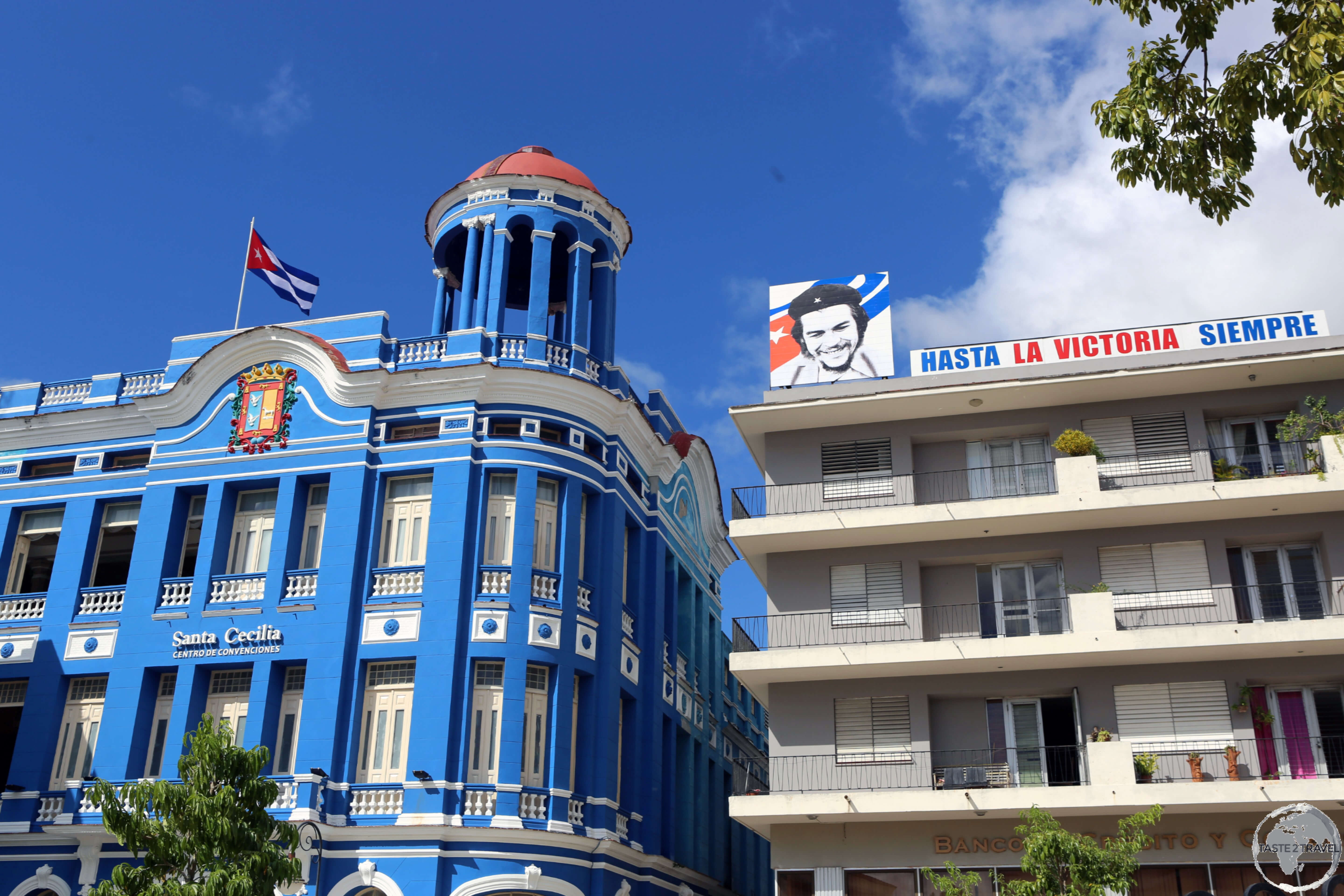
The blue Santa Cecilia Convention Centre is an architectural gem in Camagüey old town.
The charming city of Camagüey (population: 321,000) is the capital of the province of the same name and the nation’s third largest city. The city was initially founded on the coast as one of the seven original settlements (villas) by the Spanish. They moved the settlement inland to its present location in 1528.
Of all the cities I visited on my meander through Cuba, Camagüey was my favourite. At its heart is a charming old town whose layout is very haphazard and confusing (part of its charm – you’re bound to get lost at some stage).
The maze-like design was a deliberate move which came after Henry Morgan (the famous Pirate) burned the city in the 17th century. Town planners rebuilt the city with a confusing street layout so attackers would find it hard to move around inside the city.
The very blue Santa Cecilia Convention Centre is an architectural standout in the old town as are the numerous plazas.

A barber shop in the old town of Camagüey.
In the heart of the old town is the main plaza – the beautiful Parque Ignacio Agramonte. If you wish to connect to WiFi, you’ll find it here – just look for the hoard of locals.
The old town was designated a UNESCO World Heritage Site in 2008 and offers enough attractions to keep you busy for a day or two. Within the old town you’ll find lots of restaurant’s, bar’s, cafe’s, museum’s and art galleries/ studios.
The city claims to be Cuba’s Catholic Soul, and it backs this up with a multitude of churches, which dot the old town. On the main square you’ll find the dominating Iglesia Catedral de Nuestra Señora de la Candelaria (Our Lady of Candelaria Cathedral) which is a Roman Catholic Cathedral dedicated to the patron saint of the city – the Virgen de la Candelaria.

Playing chess in an old town cafe in Camagüey.
Plaza San Juan de Dios is named after its chief occupant – the church of San Juan de Dios. The neighbourhood around the plaza is very picturesque and it’s here you’ll find lots of artist studios and numerous restaurants, which line and surround the square. It’s most lively in the evenings when the restaurants are full of diners.
Holguín

A bronze, bas-relief mural, titled Origenes, is a highlight of the Parque de las Flores in Holguin.
The bustling city of Holguín (population: 326,0000) is the capital of the province of the same name. At the heart of the city lies the graceful old town, with its square’s, park’s and historic cathedral’s. The city holds enough attractions to keep you busy for a day, with most of the sights within the old town.
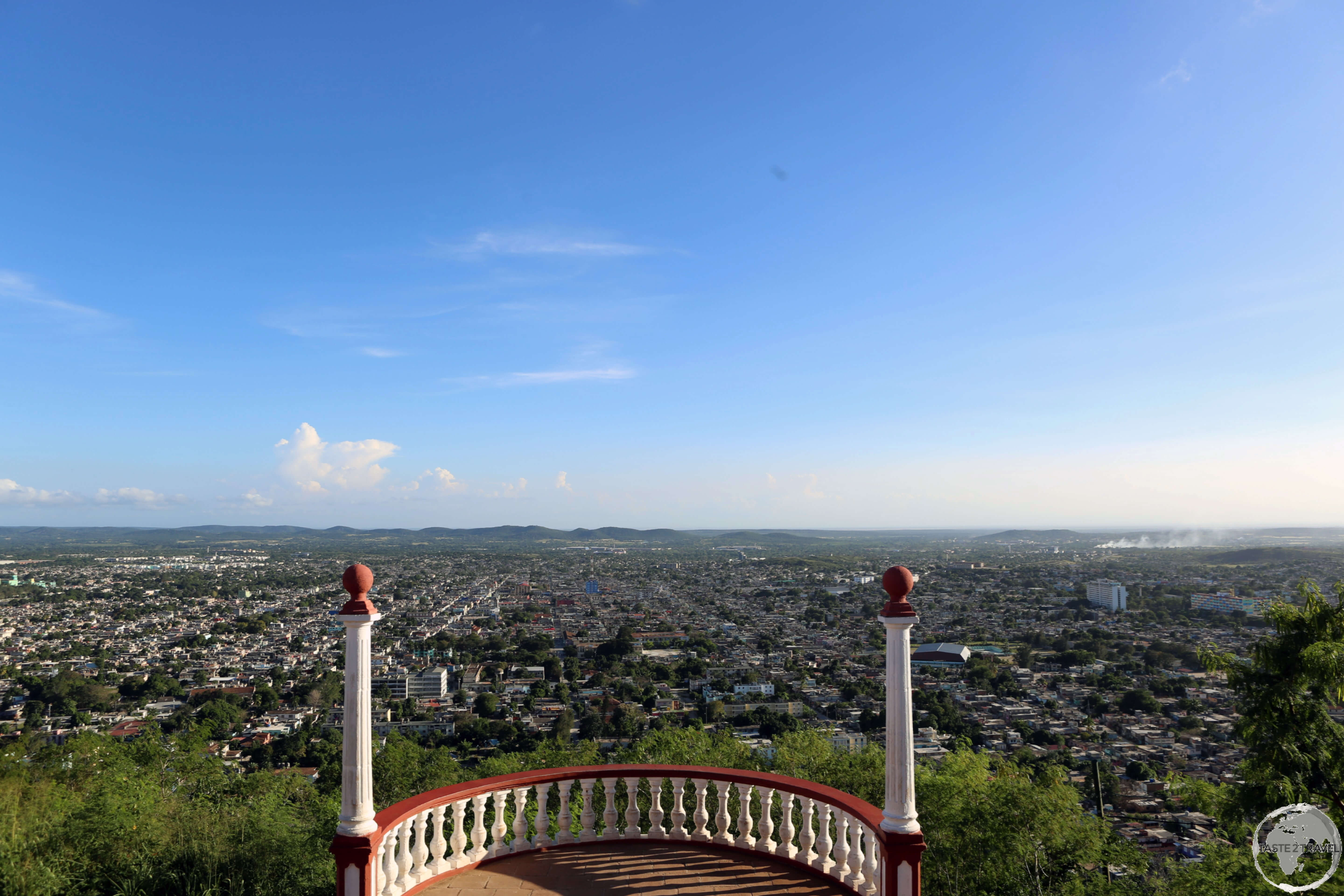
A panoramic view of Holguin from the summit of Loma de la Cruz (Hill of the Cross).
The best place to gain an overview of the city (and get your orientation) is from the top of Loma de la Cruz (Hill of the Cross).
Located at the end of Maceo, a 20-minute walk from the centre of town (or a short bicitaxi ride), 465 steps lead to the summit (275 metres), which offers panoramic views of the city and beyond. A great place to get your orientation before plunging into the narrow, busy streets of the old town.
In the centre of the old town is the ‘very white’, twin-domed Catedral de San Isidoro, which was constructed in 1720.
Holguín is known as the ‘City of Parks‘ and one of the nicest is Parque Calixto García, which is located in the heart of the old town. The park was originally laid out in 1719 as the original Plaza de Armas and has served as a meeting point/ marketplace ever since. At the centre of the park is a statute of General Calixto García (his tomb is nearby), around which you’ll find locals relaxing and vendors selling their wares.
Santiago de Cuba

Located in the heart of Santiago de Cuba, the Bacardí Museum and the Palacio Provincial are two Hellenic-style buildings built during Cuba’s 20th-century neoclassical revival.
Located at the far eastern end the island, historic and charming Santiago de Cuba (population: 473,0000) is Cuba’s second largest city and the capital of the province of the same name.
The city was the fifth village founded by the Spanish Conquistador – Diego Velázquez de Cuéllar – in 1515. The settlement was destroyed by fire in 1516, and was immediately rebuilt. It was from here that Hernán Cortés departed on his expedition of the coasts of Mexico in 1518.

Typical street scene in the old town of Santiago de Cuba.
It was also from Santiago de Cuba that Hernando de Soto departed on his expedition to Florida in 1538. It was the first European expedition which travelled deep into the territory of the modern-day United States, travelling overland through Florida, Georgia, Mississippi, Alabama and Arkansas. He is the first European documented as having crossed the Mississippi River.

During my visit to Santiago de Cuba, hand sanitising stations were helping prevent the spread of a nasty virus.
The streets of the old town are lined with examples of fine colonial architecture some of which have been converted into museums. It’s here you’ll find the Museo Municipal Emilio Bacardí Moreau, which was founded in 1899 by the rum-magnate and city mayor, Emilio Bacardí y Moreau. The museum is one of the oldest in the country and features an eclectic collection of exhibits amassed from Bacardí’s travels.

A view of Parque Cespedes, with the Hotel Casa Granda (white building) and the Catedral de Nuestra Señora de la Asunción
The heart of Santiago de Cuba is Parque Céspedes, which is more formerly known as Plaza Carlos Manuel de Céspedes. At the centre of the square is the bronze bust of Carlos Manuel de Céspedes, a key proponent of Cuban independence.
Casa de Diego Velázquez

Located in the heart of Santiago de Cuba, Cuba’s oldest house, the Casa de Diego Velázquez is today a museum.
The square is surrounded by the most historic buildings in the city, including the oldest house in Cuba, the Casa de Diego Velázquez, which has now been converted into the Museo de Ambiente Histórico Cubano.

Interior of the Museo de Ambiente Histórico Cubano in Santiago de Cuba.
Built in 1515 for Cuba’s first governor, Diego Velázquez, this is the oldest house still standing in Cuba and arguably the oldest in Latin America.

The wooden screens of the Casa de Diego Velázquez were designed so the occupants could look out but outsiders couldn’t look in.
The Casa de Diego Velázquez features an Andalusian-style façade with fine, wooden lattice windows on the second floor overlooking a central courtyard, which is refreshingly cool on a hot day.
Municipal Culture House
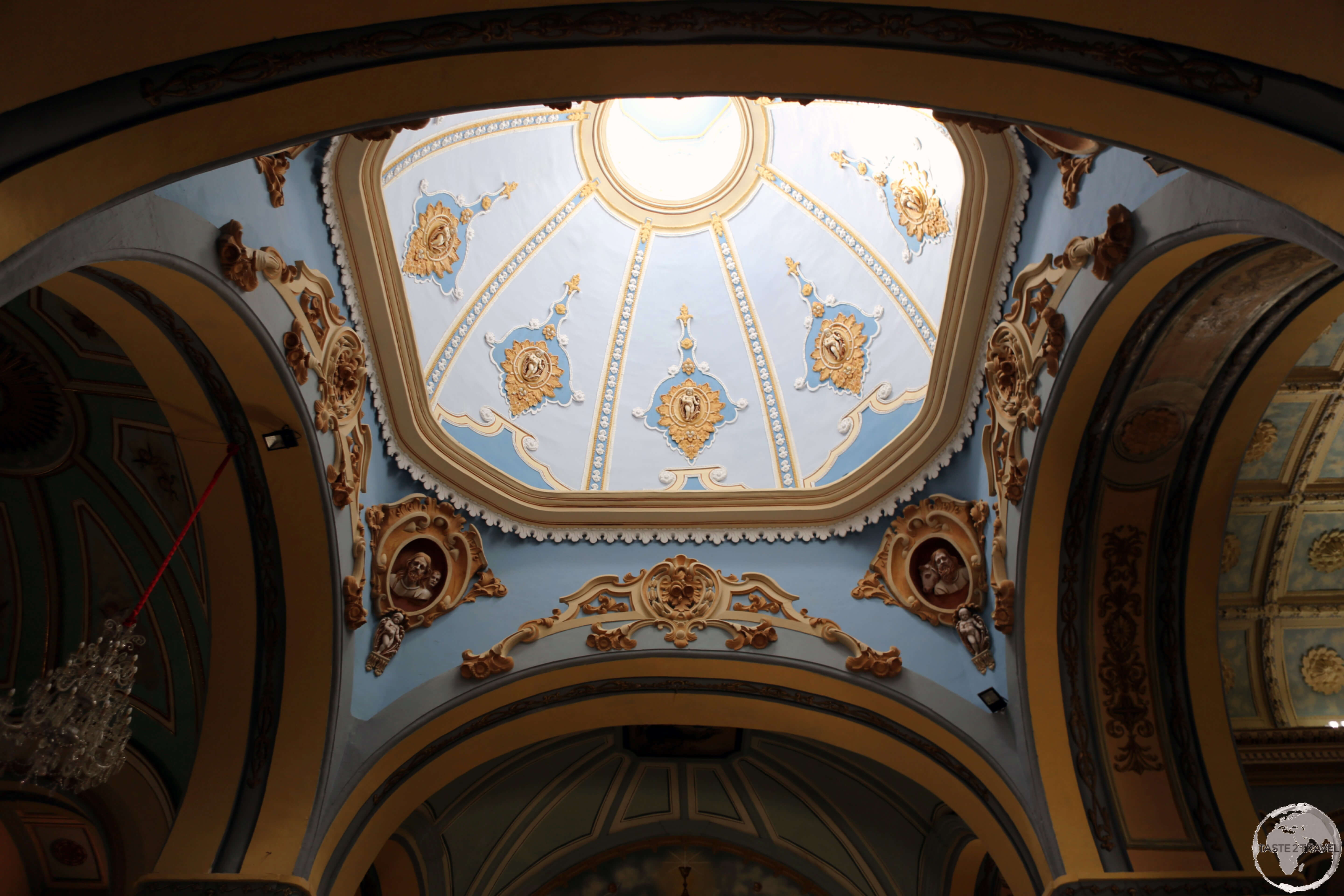
The Interior of the Municipal Culture House in Santiago de Cuba.
Located on the eastern side of Parque Cespedes, next door to the Hotel Casa Granda, the Municipal Culture House is considered the most important exponent of eclectic architecture in Santiago.

The ornate Esteban Salas Concert Hall at the Municipal Culture House in Santiago de Cuba.
Built from 1908-1912 as the San Carlos Club, this landmark building has been home to several institutions, becoming the Municipal Culture House and the Esteban Salas Concert Hall in the 1980s.Bacardí Rum Factory

Displays at the Bacardí Rum Factory in Santiago de Cuba.
Also, in the old town of Santiago de Cuba is the original Bacardí Rum Factory. It was here that the Spanish-born founder Don Facundo dreamed up the world-famous Bacardí bat symbol after discovering a bat colony in the factory’s rafters.

Memorabilia at the Bacardí Rum Factory in Santiago de Cuba.
Although the Bacardí family relocated the business to Puerto Rico at the time of the revolution, the Cuban government continues to make traditional rum here – including Ron Santiago.
Moncada Barracks

The birthplace of the Cuban revolution, Moncada Barracks in Santiago de Cuba which are still riddled with the bullet holes from Fidel Castro’s raid.
Santiago was the birthplace of the Cuban revolution, when Fidel Castro led a small contingent of rebels on an ill-prepared armed attack on the Cuartel Moncada (Moncada Barracks), which is today a museum. Housed inside the Moncada Barracks, the exhibits provide details (sometimes gory in detail) of the failed 1953 attack by Fidel Castro and his band of rebels.
Accommodation
Introduction
In the early years of the 20th century, Cuba was a favoured playground for American tourists, then Fidel Castro appeared on the scene and ended the party.
Following the revolution in 1959, and for most of the later part of the 20th century, Cuba was closed to tourism – hidden away behind the Coconut curtain.
It was only in the 1990’s when the Soviet Union (Cuba’s main trade partner) collapsed – withdrawing its support from its former ally – did Cuba (out of economic necessity) start to open itself to tourism.
Room Shortage
For most of the 21st century tourists to Cuba have come from Canada and Europe but with the thawing of relations with the United States, American tourists are now flooding into Cuba.
Unfortunately, with just 60,000 hotel rooms in the country (many in dilapidated state-run hovels), the country is suffering from a severe shortage of accommodation.
In some cities (e.g. Holguín – population 300,000) there are just two hotels located on the outskirts of the city – and these are permanently block-booked by European tour groups.
It’s the same story in Santiago de Cuba and many other cities. If you arrive in a city without a hotel reservation you should not expect to find a room (at least in a hotel) – you will need to find a room in a Casa particular.
Casa Particular
The saving grace for many visitors to Cuba is the Casa particular. Like B&B’s in other parts of the world, rooms in private family homes are made available for payment.
I stayed in a number of Casa’s during my time in Cuba with my favourite being the immaculately clean Casa Guevara Alba B&B in Havana (refer to the “Accommodation – Havana” section below).
Most Casa’s charged 25 CUC per night and often offered breakfast for an additional charge. The best websites for finding Casa’s are trivago.com, Airbnb.com and BedyCasa.com
Havana

My comfortable room at Casa Guevara Alba B&B in Havana.
Not surprisingly, Cuba’s capital and most populous city offers more hotel options than anywhere else in the country. Hotels range from charming colonial establishments, which line the cobbled streets of Old Havana to modern, towering hotels located in the newer districts of the city.
Throughout the city there’s a good selection of Casa particulars which can be booked from websites such as trivago.com, Airbnb.com and BedyCasa.com.
While in Havana I stayed in two very different Casa particulars – the charming, spotlessly clean, friendly, family-run Casa Guevara Alba which is located in the suburbs and a rustic, old Casa which was conveniently located in the heart of the old town.
I also managed to secure a room at the legendary Hotel Inglaterra. Founded in 1875, the Inglaterra is Cuba’s oldest hotel and has been declared a National Monument. Overlooking Central Park and adjacent to the Capitol building, the hotel is the most convenient address in the city, being a short stroll from most sights in Old Havana. The street-side covered café is always buzzing with activity, a place where tourists and locals can relax at tables individually decorated by Cuban artists, listen to live bands, enjoy a meal, coffee or Mojito and watch the world go by.
Cienfuegos

The charming 4-star La Union Hotel is located in the heart of Cienfuegos and almost always fully booked.
Cienfuegos is another city where the rooms in established hotels (including the charming La Union Hotel – pictured above) are normally block-booked by tour groups.
Located on the coast, a short taxi ride south of the city centre is the enclave of Punta Gorda, which is home to several hotels, including the Hotel Jagua – the biggest hotel in town.
While in town, I stayed with a young, entrepreneurial family in a beautiful, modern, contemporary-designed house which I found on BedyCasa.com.
Trinidad

The charming old town of Trinidad is a tourist hotspot and home to many Casas particulares.
Beautiful Trinidad has a population of 73,000 but walking around the busy cobbled streets of the old town, it’s easy to imagine there are even more tourists than locals in town at any one time. Like elsewhere in Cuba, Casa particulars save the day here.
I stayed in the Hotel Las Cuevas which is built on a natural veranda above the city, offering panoramic views of the Caribbean Sea and the old town below.
Sancti Spíritus

Exterior of the charming Hotel del Rijo in downtown Sancti Spiritus.
My favourite hotel in Sancti Spiritus is the beautifully restored, colonial-era Hotel del Rijo. The added bonus here is that you can actually book a room, with tour groups clearly staying elsewhere!
Overlooking Park Honorato, this impressive mansion was built between 1818 and 1827 for a wealthy, local family. It was renovated in 2001 and later converted into a hotel.
With décor that looks like Hemingway might have stayed here just yesterday, the tastefully decorated rooms are spacious and comfortable and include black & white photos of the old town.

Feeling like Hemmingway in my room at the wonderful Hotel del Rijo in Sancti Spiritus.
The hotel occupies prime downtown real estate and (in my opinion) is the only place to stay while in town. It’s location opposite the main Parochial Church, close to the main shopping street and nearby the Yayabo river make this the perfect base for exploring the city.
The front-side alfresco restaurant, which overlooks the peaceful Parque Honorato, offers wonderful Cuban cuisine.
Ciego de Ávila
Most tourists visiting Ciego de Ávila province stay on the north coast at Cayo Coco, which is a good thing since most hotels in the capital (same name as the province) are old, dilapidated, state-run dives. The best of a bad bunch is the colonial-style Hotel Sevilla.
While in Ciego de Ávila city, I stayed in an unremarkable Casa particular in the heart of the downtown area.
Camagüey
The charming, historic city of Camagüey is a popular stop for tour groups and, unlike other Cuban cities, offers a reasonable selection of hotels, some of which are beautifully refined colonial-era establishments.
I stayed in one such place – the centrally located Gran Hotel – which once accommodated Hemingway and offers comfortable rooms for €65 per night. The hotel is located in the heart of the business district and is a short walk from most sights.
There are also many Casa Particular’s in the city, which can be reserved through trivago.com, Airbnb.com or BedyCasa.com
Holguín
Despite having a population of 300,000 people, there is a dearth of hotels in Holguín. The city boasts just two – the Islazul Pernik and the Islazul El Bosque (both of which are part of the state owned Isalzul group and are old and faded affairs).
The hotels are located next to each other on the outskirts of the city and are both permanently block-booked by tour groups.

A view of Holguin from Loma de la Cruz (Hill of the Cross).
When I arrived at El Bosque, the hotel had no vacancies but the helpful reception staff directed me to a family-owned Casa Particular a short walk away, which was very comfortable.
Your best bet in Holguín is to book a Casa Particular through trivago.com, Airbnb.com or BedyCasa.com
Santiago de Cuba
With a population of 430,000 – Santiago de Cuba is Cuba’s second largest city and, like most other cities, it offers very few hotel rooms.
One of the few hotels in town is the delightfully eclectic Hotel Casa Granda. Built in 1914, the hotel overlooks Parque Cespedes (the main square) and is a short walk from all attractions. Unfortunately, like so many other hotels in Cuba, the rooms are normally block-booked by tour groups.
Even if you’re not a guest at the Casa Granda, you’ll probably find yourself spending time at the lively terrace café/ bar. With views over the main square, live music and delicious Mojito’s, it’s the best place in town to unwind after a hard day of sightseeing.

The swimming pool at the Meliá Santiago de Cuba.
Located 2.5 kilometres from Parque Cespedes is the modern, 5-star Meliá Santiago de Cuba, which has the best pool in town (open to non-guests for a fee).
I stayed in a family-run Casa which I was directed to by a helpful local. There are plenty of Casa Particular’s in the city, which you can reserve through trivago.com, Airbnb.com or BedyCasa.com
Eating Out

A typical bar in Havana old town.
Cuban cuisine is a blend of Native American Taino food, Spanish, African and Caribbean cuisines. A typical meal consists of rice and beans, which – when cooked together – is called “congri” or “Moros”.
The good news for diners is that under Raul Castro’s economic reform programme (since 2010) there has been a wave of new private restaurants (paladares) open around the country, especially in Havana. Dining in Cuba has gone from once being a chore to now being a pleasure, with a wealth of options serving decent food with lots of ambience and good service.
Cuban Sandwich

The ubiquitous and popular Cuban sandwich, served in a cafe in Havana old town.
A popular snack is the Cuban sandwich which is also referred to as a mixto.
The sandwich is a popular lunch item which was first created as a snack for cigar workers who travelled between Cuba and Florida in the 1800’s.
Typically, the sandwich is built on a base of lightly buttered Cuban bread and contains sliced roast pork, thinly sliced Serrano ham, Swiss cheese, dill pickles, and yellow mustard.
Ropa Vieja

Ropa Vieja (old clothes) is a popular dish in Cuba.
One of my favourite Cuban dishes is Ropa Vieja (translates as ‘old clothes’), which is slow-cooked shredded beef (or lamb) served in a tomato sauce with different vegetables. It’s a very tasty stew!
The name comes from the fact that the dish can look like a pile of shredded old clothes. Old clothes or not – it’s delicious and so popular it’s been designated a national dish.
Havana

The ornate dining room at the Hotel Inglaterra, a landmark hotel in Havana old town.
One thing you can be sure of in a great, cosmopolitan city such as Havana is that you are never far from your next dining option. La Habana Vieja (the old town) is the epi-centre of the Cuban culinary world with restaurants, bars and cafes around every corner.
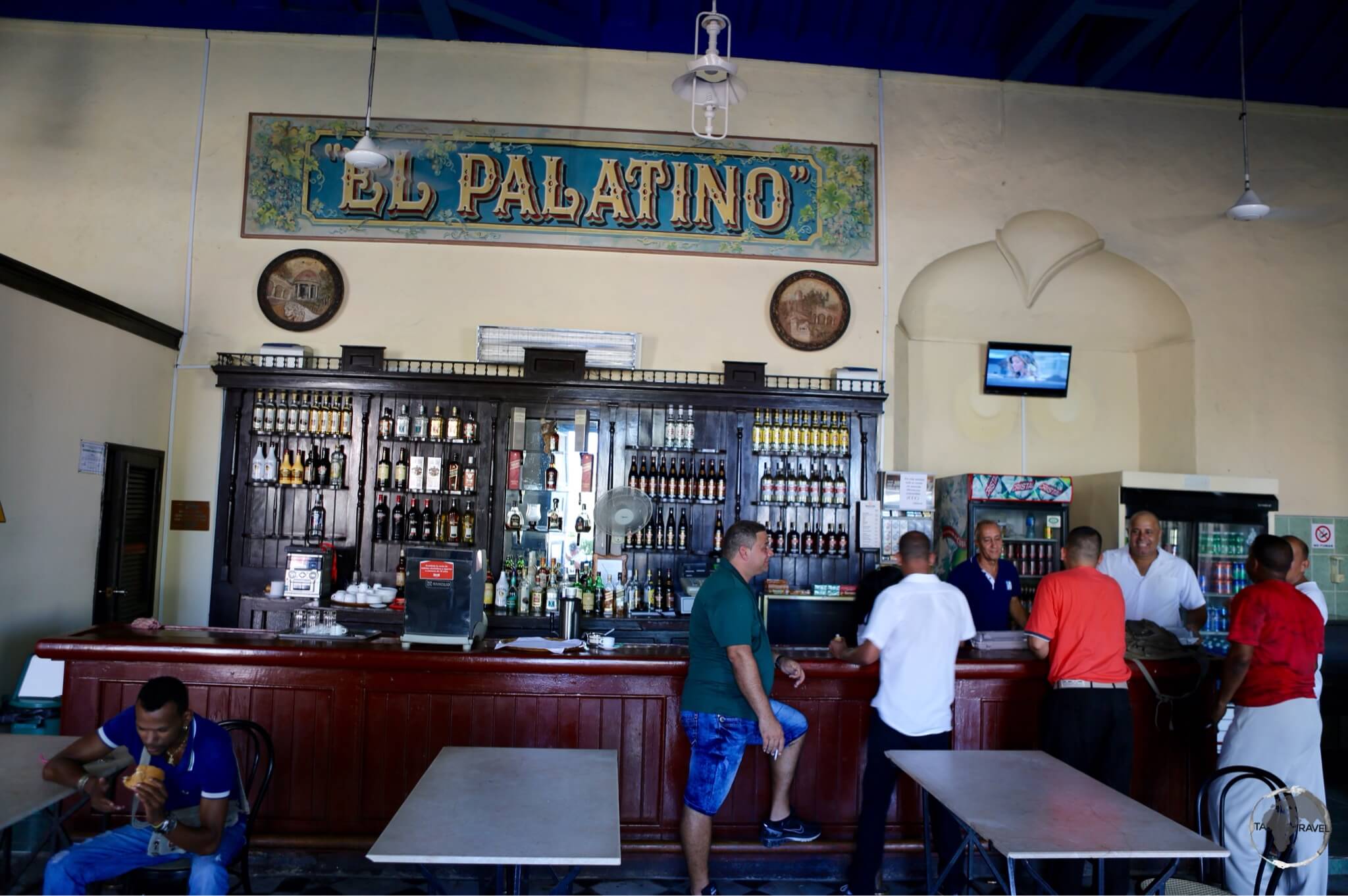
A typical bar in Havana old town.
With more (private) establishments opening constantly, the dining scene in Havana is forever changing. And when not eating you can relax in one of the many bars, listen to live music (which can be heard day and night), sip a Mojito, watch some salsa dancing and soak up the atmosphere of this wonderful Caribbean metropolis.
“My mojito in La Bodeguita, my daiquiri in El Floridita.” – Ernest Hemingway
Due to the high number of tourists in the city, any restaurant in the old town is invariably a tourist trap.
Of all the establishments, the two favourite watering holes of Ernest Hemmingway – La Bodeguita del Medio and El Floridita attract most of the attention, with hordes of tourists lining up to get a seat at the bar.
Hemmingway certainly enjoyed his rum cocktails and was said to favour the Mojito at La Bodeguita and the Daiquiri at El Floridita.
Fresh Lime Juice

A divine fresh lime juice at the Museo de la Revolucion in Havana.
Despite Cuba being the land of amazing rum cocktails, one of my favourite daytime drinks were the amazing fresh lime juices which are served at restaurants and cafes throughout the island. Always sweetened with simple syrup, there’s nothing more refreshing in the tropical heat!
A good lunchtime option (and definitely a tourist trap), which offers panoramic views over the centre of the old town, is the rooftop restaurant at the Hotel Ambos Mundos.
The hotel was built in the 1920’s and was frequented by Ernest Hemingway (you can visit his former room – # 511 – which has been converted into a museum). The food and service are reasonable but it’s the views that make a visit worthwhile.
The street-side Gran Café el Louvre at the beautiful Hotel Inglaterra is worth mentioning for its carnival-like atmosphere.
Located opposite Parque Central, and offering live music (day and night), Mojito’s, snack’s and good coffee, the Louvre is a great place to relax and watch the world go by. If the circus atmosphere becomes too much you can retire inside to the quiet, ornate, air-conditioned restaurant, which is full of old-world charm. For something really special you should venture to the rooftop terrace where you’ll find a quieter bar.
Cienfuegos

The neoclassical mansions which line Paseo del Prado in Cienfuegos are home to some fine dining options, including the wonderful Restaurante Doña Nora.
There’s no shortage of good restaurants in Cienfuegos, many of which can be found along the main Paseo El Prado – which runs for many kilometres from downtown to the coast at Punta Gorda.
Located downtown on the corner of Paseo El Prado and Calle Arguelles is Restaurante Doña Nora, one of my favourite restaurants in Cienfuegos.
This establishment was one of the first private restaurants to open in the city and was recommended to me by my Casa particular host. Although not as cheap, as a government-run establishment, the food, service and ambience are worth the extra cost.
Built on two floors, there’s an upstairs balcony which overlooks the main street and is used as the waiting area while you (inevitably) wait for a free table, which is no problem since you can sip one of their amazing Mojito’s while appreciating the views.
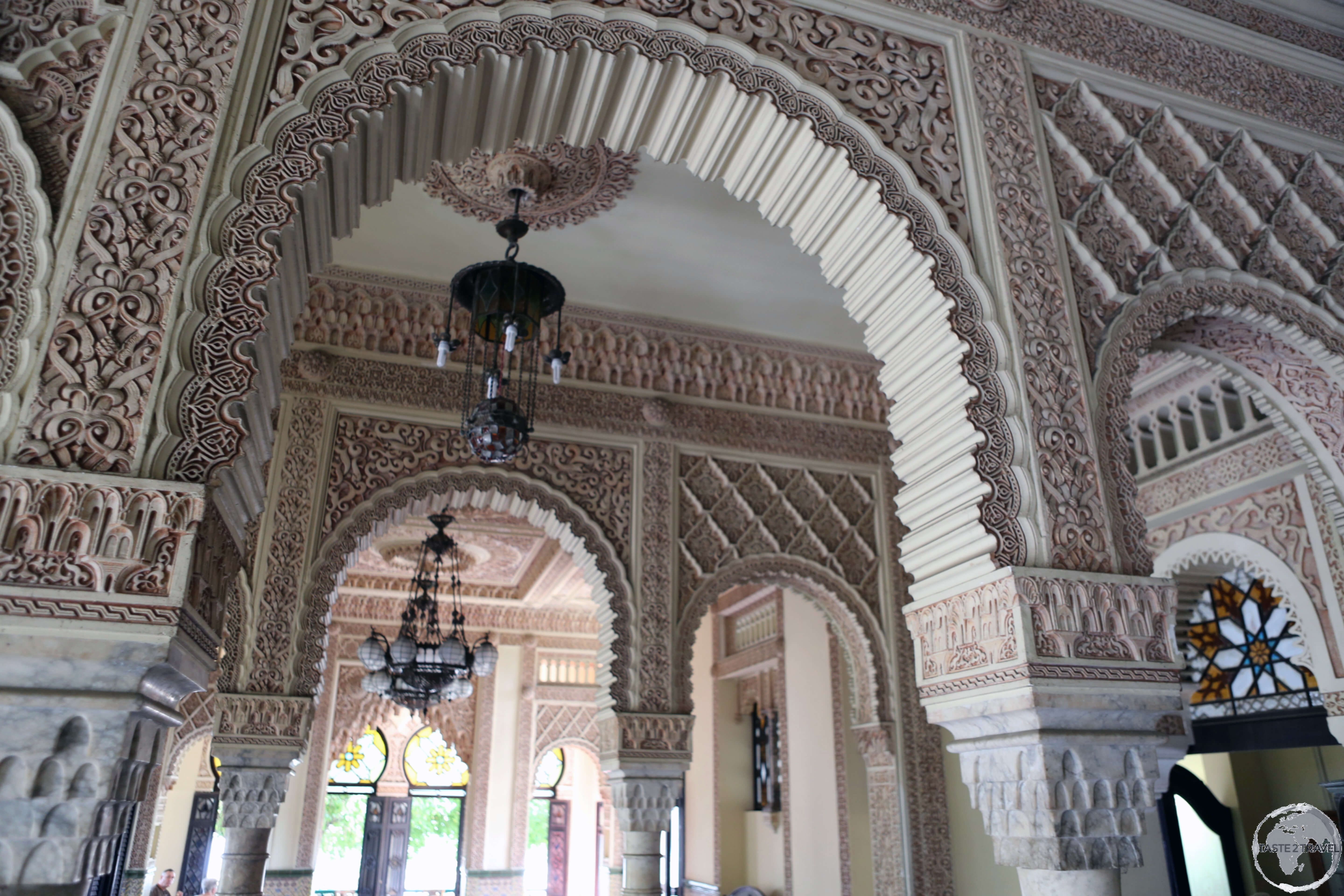
The ornate, Moorish-style interior of the Palacio de Valle in Cienfuegos.
Located next to the Caribbean Sea in the Punta Gorda enclave is the opulent and ornate Palacio de Valle.
Once the home of a wealthy merchant and built in a Moorish style, the palace is worth visiting – even if just to photograph. Meals here are good (but not spectacular) and there’s a rooftop bar which offers panoramic views of the Caribbean.
Trinidad

Lunch at Restaurante Guitarra Mia (My Guitar) in Trinidad old town.
Despite its small population (78,000), Trinidad punches well above its weight when it comes to culinary offerings. Within the picturesque old town, the cobbled streets and tranquil squares are lined with restaurant’s, bar’s and cafe’s, all catering to the ever-present tourist hoards.
Located a short walk from the main Plaza Mayor (at # 19 Jesus Menendez Alameda) is the quaint and cosy Restaurante Guitarra Mia (My guitar). The beautifully presented, tasty food, service, ambience and live music ensure a memorable dining experience.
In the evening the cobbled streets around the Plaza Mayor come alive with the bustle of tourists and locals, with many restaurants, bars and cafes offering Cuban and International cuisine and lots of quaffable rum cocktails. Located on the square, the excellent Sol Ananda is a cross between a museum (it’s packed with antiques) and a restaurant. The speciality here is the amazing lamb Ropa Vieja.
Sancti Spíritus

A fresh lime juice at Restaurante Quinta Santa Elena – a great refresher while exploring Sancti Spiritus.
The best meal I had in Sancti Spiritus was at the Taberna Yayabo which overlooks the Yayabo river (next to the old stone bridge). As you enter, it’s hard to miss the row of Serrano hams hanging from the bar. The Taberna offers Cuban cuisine and tapas (focused on ham and cheese) with a good selection of wines. The best seats in the house are outside on the balcony which overlooks the river.
Located on the banks of the Yayabo river (across the road from the Taberna) is the historic (and iconic) Restaurante Quinta Santa Elena which offers Cuban cuisine, great cocktails and fresh lime juice – all served in their shady riverside garden.

A bakery in Sancti Spíritus old town.
The charming Restaurant Hotel Del Rijo is located on the cool, breezy, covered ground-floor of the majestic Hotel Del Rijo (see “Accommodation – Sancti Spiritus“). Overlooking the peaceful Parque Honorato, the restaurant offers Cuban cuisine at reasonable prices.
Ciego De Avila
In terms of cuisine, there’s nowhere in Ciego de Avila city that’s setting the world on fire. Located on Marcial Gómez (adjacent to the main square), the restaurant Don Avila has the best bar in town, a cigar outlet and reasonable Cuban and Creole food. The restaurant is busiest during lunch and has a nice alfresco dining area.
A short walk from Don Avila – at Independencia 388 – is Restaurante Blanco Y Negro, which serves good international & Cuban cuisine.
Camagüey

One of many cafes to be found in the charming old town of Camagüey.
Located in the old town, the serene Plaza San Juan de Dios is lined with cafe’s and restaurant’s and is a wonderful place to spend a relaxing evening enjoying cocktails, fine food and live music. The square is surrounded by artist studio’s, which line the quiet cobbled streets. The whole neighbourhood has a great vibe and ambience.
The main restaurant on the square is the impressive Restaurant 1800 which offers a good selection of Cuban and international cuisine.
Holguín
A standout restaurant in Holguín is the 1910 Restaurante & Bar (address: 143 Mártires). Located in the heart of the old town, 1910 offers very tasty Cuban and Spanish cuisine.
Santiago de Cuba

Live music at Casa de la Trova in Santiago de Cuba.
Being the birthplace of Bacardi (since relocated offshore), Santiago de Cuba is still a major rum producer and a great place to party. Live music can be heard day and night in the bars around the old town with a popular place being Casa de la Trova (located near the Hotel Casa Granda on Bartolomé Masó street).
The best place in town to relax with a rum-based cocktail (made from local rum of course!) is the terrace restaurant/ bar at the Hotel Casa Granda. Overlooking the (always busy and entertaining) main square – Parque Céspedes – the terrace is a popular meeting place for tourists, touts and locals. While the cocktails demand respect, the food offerings are less than inspiring with burgers, hot dogs and sandwiches available.
Opposite the Hotel Casa Granda, (overlooking the cathedral) is the best seafood restaurant in town – Thoms Yadira Restaurant. I highly recommend their seafood Brocheta’s.
Located at the end of a corridor (enter from Calle Saco), near to Parque Plaza de Marte, is Santiago’s #1 restaurant – a true hidden gem – St. Pauli. Although hidden, the restaurant is no secret and is a favourite lunch stop for tour groups during their city tour’s. The menu is wonderfully varied and the food (Cuban/ Caribbean) is delicious.

Chocolate selection at Chocolateria Fraternidad in Santiago de Cuba.
Adjacent to Parque Plaza de Marte (on the southeast corner) is Chocolateria Fraternidad, which is famous for its ice-cream, hand-made chocolates and hot chocolate drinks. Although their chocolates come in a variety of different shapes, there’s no variety in their flavour or fillings with all their offerings simply being chunks of either solid milk, white or dark chocolate – wonderfully symbolic of Cuba – where ‘variety’ is rarely on offer.
Visa Requirements
The visa policy of Cuba is surprisingly simple. Prior to arrival, most nationalities are required to purchase a green ‘Tourist Card‘ (Tarjeta del Turista) which costs US$25. A tourist card grants a maximum stay of 30 days (90 days for Canadians) and can be obtained from Cuban missions, travel agencies or the airline (the one which will fly you into Cuba).
The easiest way to obtain the card is to purchase it directly from the airline at the airport. I flew from Santo Domingo (Dominican Republic) to Havana with Cubana and was able to easily purchase the card prior to check-in for US$25 cash. If your flight is originating from the United States, a pink Tourist Card will be issued at a cost of US$50.
Getting There
Air

Cuba boasts 11 International airports, located in different cities and resort areas, providing travellers with increased flexibility when planning arrival and departure points from this long island. International airports are located in the following cities:
- Camaguey (code: CMW)
- Cayo Coco (code: CCC)
- Cayo Largo (code: CYO)
- Cienfuegos (code: CFG)
- Havana (code: HAV)
- Holguin (code: HOG)
- Manzanillo de Cuba (code: MZO)
- Santa Clara (code: SNU)
- Santiago de Cuba (code: SCU)
- Varadero (code: VRA)
The main gateway to Cuba is José Martí International Airport, which is located 15 kilometres (9 miles) southwest of Havana. The airport serves as the base for the national carrier, Cubana who operate International and domestic flights from the airport.
The following airlines provide scheduled services to/ from José Martí International Airport:
- Aeroflot – flies to/ from Moscow–Sheremetyevo
- Aeroméxico – flies to/ from Cancún, Mexico City
- Air Canada Rouge – flies to/ from Toronto–Pearson
- Air Caraïbes – flies to/ from Paris–Orly
- Air China – flies to/ from Beijing–Capital, Montréal–Trudeau
- Air Europa – flies to/ from Madrid
- Air France – flies to/ from Paris–Charles de Gaulle
- Alitalia – flies to/ from Rome-Fiumicino
- American Airlines – flies to/ from Charlotte, Miami
- Aruba Airlines – flies to/ from Aruba
- Avianca – flies to/ from Bogotá
- Avianca El Salvador – flies to/ from San Salvador
- Avianca Peru – flies to/ from Lima
- Bahamasair – flies to/ from Nassau
- Blue Panorama Airlines – flies to/ from Milan–Malpensa, Rome–Fiumicino
- Cayman Airways – flies to/ from Cayman Brac, Grand Cayman
- Condor – flies to/ from Frankfurt, Munich
- Conviasa – flies to/ from Caracas
- Copa Airlines – flies to/ from Panama City
- Corsair International – flies to/ from Paris–Orly
- Cubana – flies to/ from Baracoa, Bayamo, Bogotá, Buenos Aires–Ezeiza, Camagüey, Cancún, Caracas, Cayo Coco, Fort-de-France, Guantánamo, Holguín, Las Tunas, Madrid, Managua, Manzanillo (Cuba), Mexico City, Moa, Montréal–Trudeau, Nassau, Nueva Gerona, Paris–Orly, Pointe-à-Pitre, Port-au-Prince, San José, Santiago de Cuba, Santo Domingo–Las Américas, Toronto–Pearson
- Delta Air Lines – flies to/ from Atlanta, Miami, New York–JFK
- EasySky – flies to/ from Tegucigalpa
- Edelweiss – flies to/ from Air Zürich
- Evelop – flies to/ from Airlines Madrid
- Fly All Ways – flies to/ from Paramaribo
- Iberia – flies to/ from Madrid
- InterCaribbean Airways – flies to/ from Providenciales
- Interjet – flies to/ from Cancún, Mérida, Mexico City, Monterrey
- JetBlue Airways – flies to/ from Fort Lauderdale, New York–JFK, Orlando
- KLM – flies to/ from Amsterdam
- LATAM Perú – flies to/ from Lima
- Meridiana – flies to/ from Milan–Malpensa
- PAWA Dominicana – flies to/ from Santo Domingo-Las Americas
- Plus Ultra Líneas Aéreas – flies to/ from Barcelona
- Southwest Airlines – flies to/ from Fort Lauderdale, Tampa
- Sunrise Airways – flies to/ from Port-au-Prince
- TAAG Angola Airlines – flies to/ from Luanda
- TAME – flies to/ from Quito
- Turkish Airlines – flies to/ from Istanbul-Atatürk
- United Airlines – flies to/ from Houston–Intercontinental, Newark
- Virgin Atlantic – flies to/ from London–Gatwick
- Wingo – flies to/ from Bogotá
Cruise Ship
A variety of Cruise Ship companies offer cruises to Cuba. For the latest schedules and prices, you should check the following websites:
Getting Around
Air
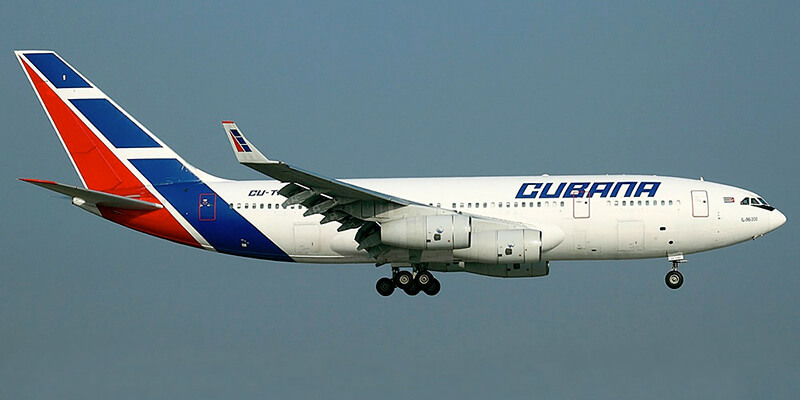
Cubana are the national airline of Cuba.
Most domestic air services are offered by Cubana who operate a fleet of 16 planes. Apart from two ATR 72 (French) aircraft, Cubana’s fleet consists entirely of soviet-era metal, namely Antonov (Ukrainian), Ilyushin (Russian) and Tupolev (Russian).
Ticket prices are very reasonable (US$130 one way from Havana to Santiago de Cuba) which means flights are very popular and often sold-out well in advance. Flights can be booked online a variety of OTA’s including Skyscanner.
Intercity Bus

There are two national bus companies in Cuba with Viazul being the company used by tourists. This state-owned (of course!) company operates a fleet of modern and comfortable coaches which provide regular connections to most Cuban cities with journey’s typically costing around 3 CUC per hour.
Schedules and prices are available on their website where you can also book tickets. Alternatively, you can purchase tickets at any bus terminal. Some routes (e.g., Havana – Trinidad, Havana – Santiago de Cuba) are very popular so it’s recommended to book in advance.
AstroBus is a bus service which is available only to Cuban Residents who must produce their ID card when purchasing a ticket, which are payable in CUP. The fleet is comprised of modern Chinese YUTONG buses,
Colectivo
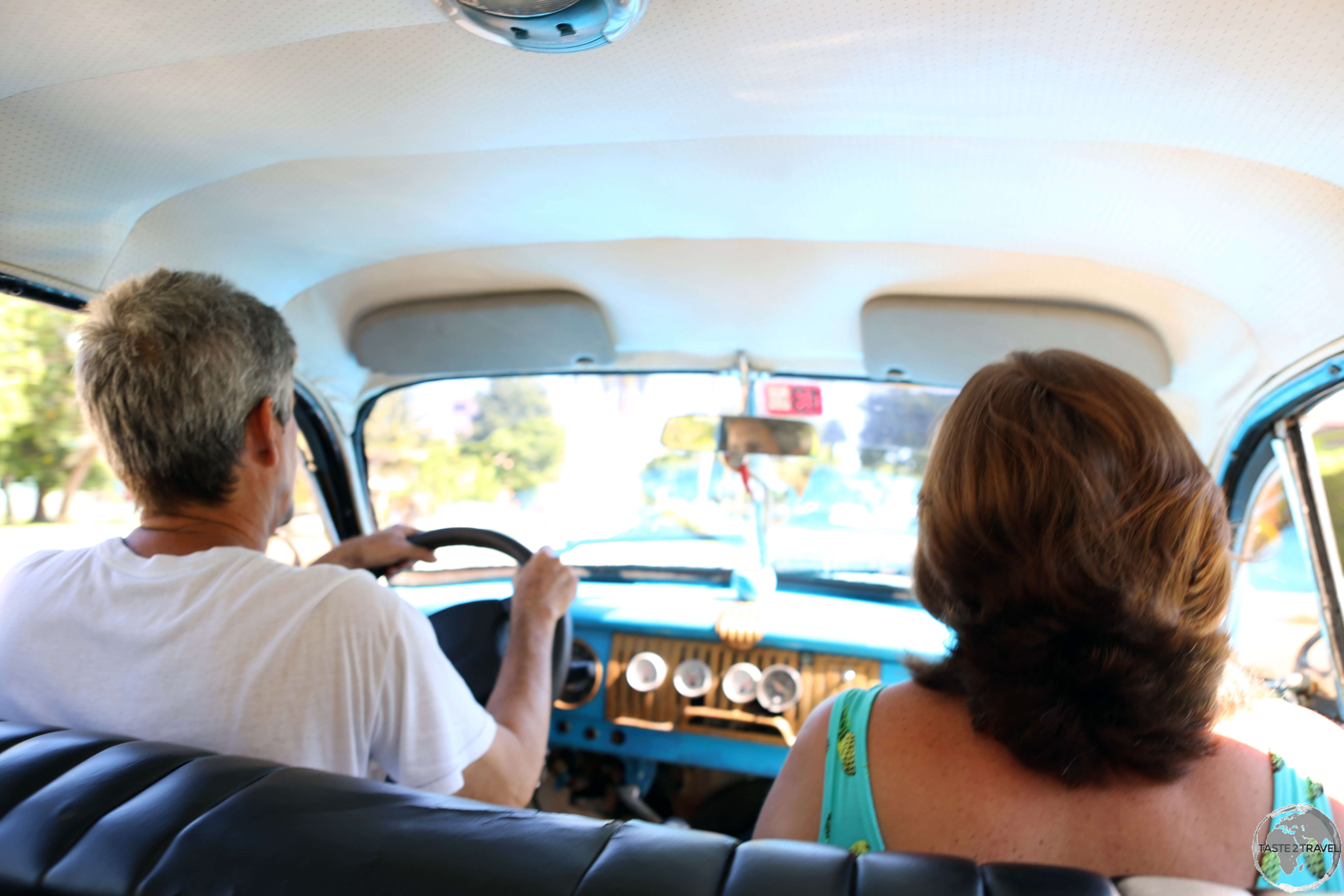
Riding in a Colectivo is a quintessential Cuban travel experience.
Colectivo’s, also known as Almendrone’s, are taxis running on fixed, long-distance routes. They are generally old (pre-revolution) American clunkers with room for two passengers up front and four in the back.

The driver of this Colectivo in Holguín told me his car was built in the United States in 1948.
In other countries these cars would be displayed in a car museum, but in Cuba they are an integral part of the public transportation system, operating like buses, dropping off and picking up on demand.
Journey’s typically cost 50 cents CUC per person.
Taxi

Riding in a taxi in Cienfuegos.
Taxi companies in Cuba are government owned and charge reasonably priced fares (compared to major cities around the world) with a typical tariff of 50 cents (CUC) per kilometre.
Taxi drivers will often offer tourists a flat, off-meter rate that usually works out very close to what you’ll pay with the meter. The difference is that with the meter, the money goes to the state to be divided up; without the meter it goes into the driver’s pocket.
Coco Taxis

An old baseball bat is all that’s needed to jack up a Coco Taxi.
A section on getting around Cuba wouldn’t be complete without mention of the iconic, yellow Coco Taxi, an auto rickshaw found only on the streets of Havana.
The Coco carries 2-3 passengers, runs on a two-stroke motor and is made of lightweight fibre-glass which makes raising the body for repairs a breeze. The Coco gets its name from its rounded body which resembles a half-coconut. These noisy, smog belching rickshaws costs less than a regular taxi.
Bicitaxi’s

Two young girls in Cienfuegos enjoying an outing in a Bicitaxi.
Bicitaxi’s are one of the best and cheapest forms of transportation in Cuba and are a great way to explore a city, with a one-hour sightseeing tour costing 5 CUC.
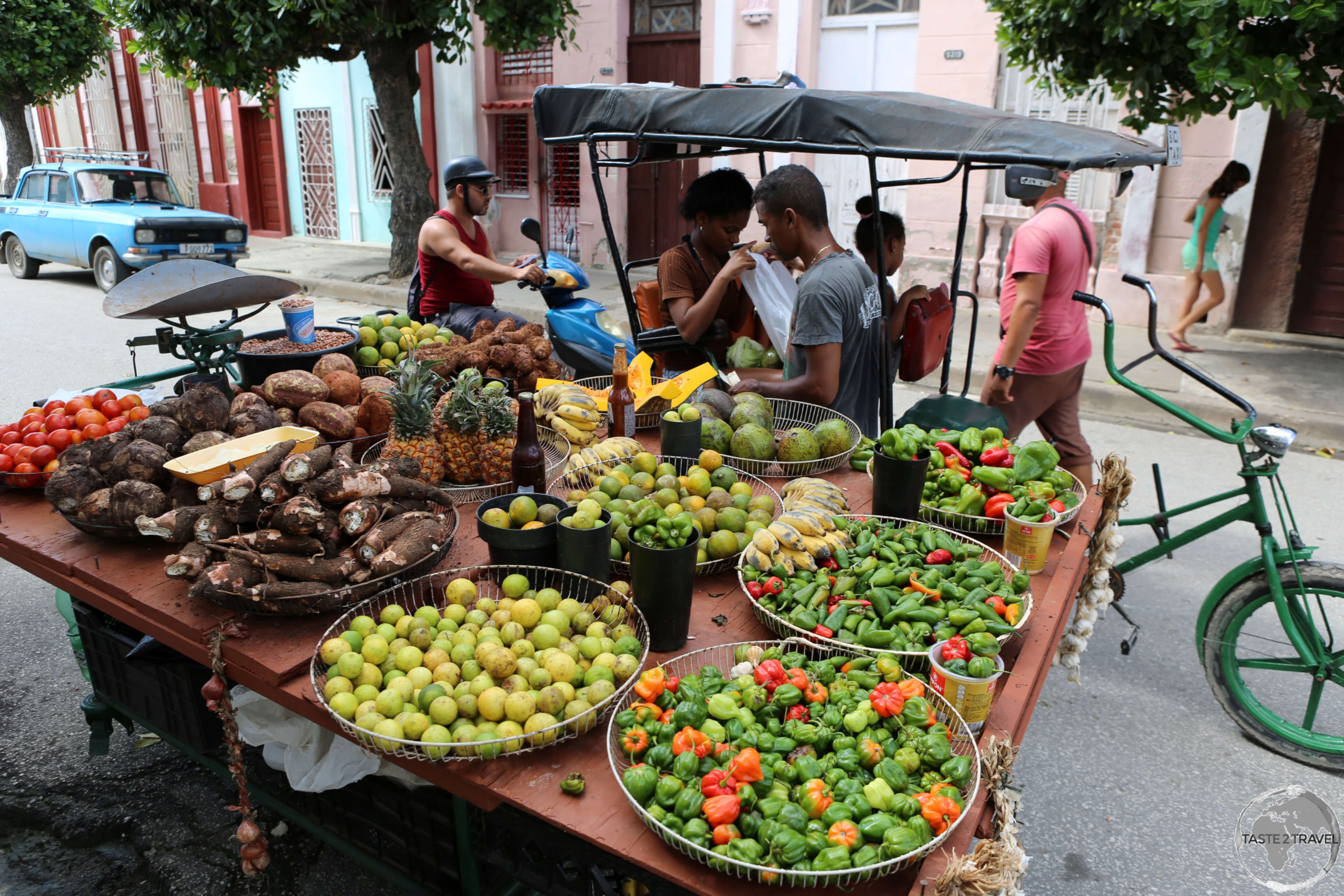
A family in Cienfuegos shopping from the comfort of a Bicitaxi.
Bici’s are pedal-powered tricycles (the Cuban Rickshaw) with a double seat behind the driver. They are commonly found in Havana and most large cities and are cheaper than taxis, but fares need to be negotiated in advance.
While locals pay 10 to 20 pesos (CUP) for a short journey, drivers will charge tourists 1-2 CUC.
Horse Carts
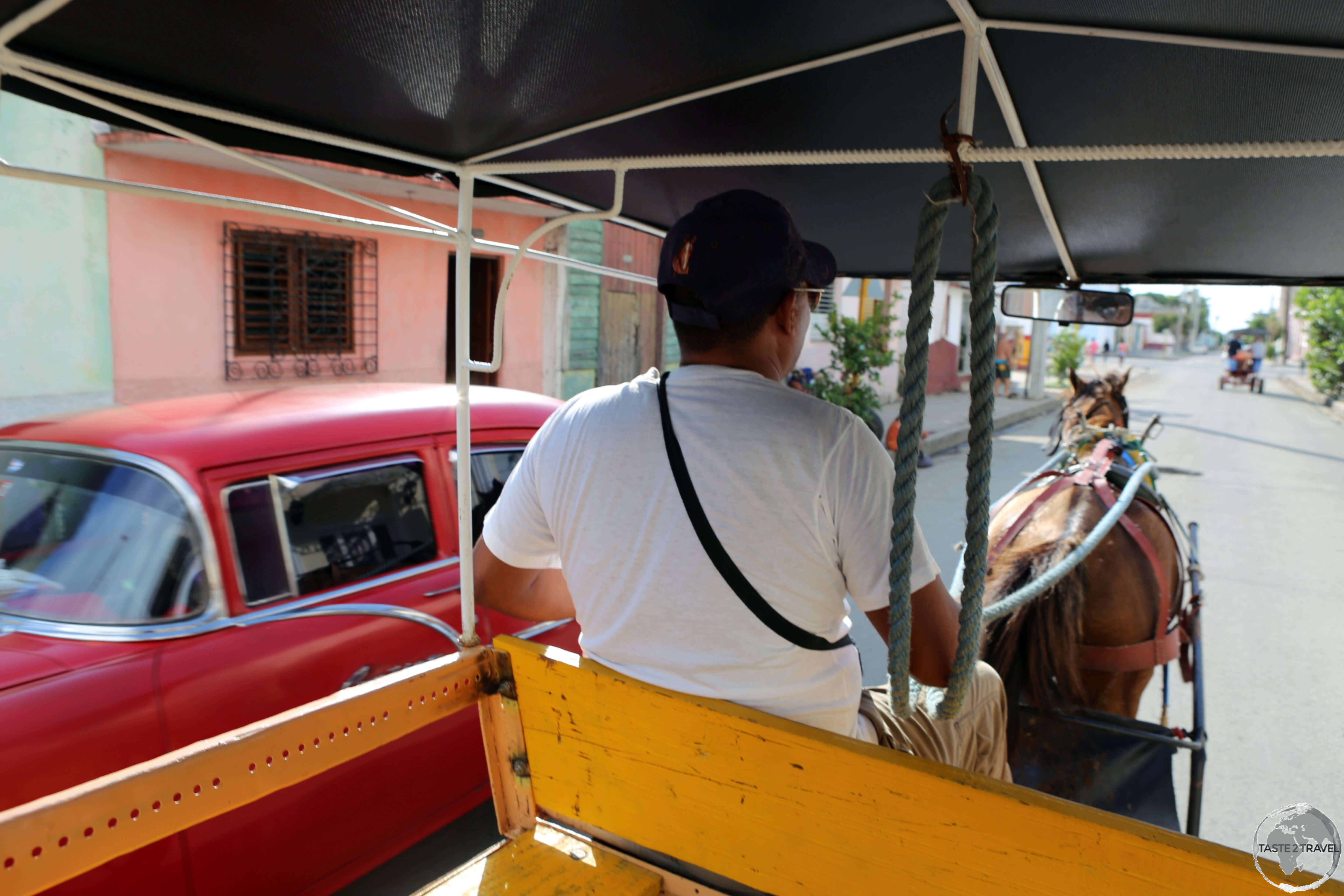
A Coches de caballo is the best way to explore Cienfuegos and other Cuban cities.
The most relaxed form of transport in Cuba, Coches de caballo (horse carriages) provide a pleasurable way to explore cities such as Cienfuegos or Camagüey.

Touring Cienfuegos in my horse carriage.
While carriages normally trot along fixed routes, they can be hired for sightseeing trips or direct point-to-point journeys with a short trip costing 1 CUC.
Train

A map of the Cuban rail network.
Source: Wikipedia
The first railway in Latin America was inaugurated in Cuba in 1837, with a 27.5 km line running between Havana & Bejucal. Built by the Spanish to transport sugar, it was constructed at a time when no railways existed in Spain.
Known for its slow, unreliable service and poorly maintained carriages, improvements are slowly happening with the government making investments in recent years in new rolling stock, with new locomotives ordered from China and new carriages from Iran. Tickets (payable in CUC) should be purchased in advance from stations.
A good source of information for everything related to Cuban train travel is ‘The man in seat 61‘.
Car Rental

Old Cuban License plates make for popular souvenirs.
Car Rental is possible in Cuba with a compact car (all manuals) costing about US$75 per day. It’s best to pre-book in advance, which you can do on several websites including TripCuba.
That’s the end of my Cuba Travel Guide.
Safe Travels to Cuba!
Darren
Follow me on Instagram:
[instagram-feed feed=1]
Further Reading
Other travel reports from the Caribbean region include:
- Anguilla
- Antigua & Barbuda
- Aruba
- Bahamas
- Barbados
- Bonaire
- Bermuda
- Cayman Islands
- Cuba
- Curaçao
- Dominica
- Dominican Republic
- Grenada
- Guadeloupe
- Haiti
- Jamaica
- Martinique
- Montserrat
- Puerto Rico
- Saba
- Saint Barthélemy (Saint Barts)
- Saint Eustatius (Statia)
- Saint Kitts & Nevis
- Saint Lucia
- Saint Martin/ Sint Maarten
- Saint Vincent & The Grenadines
- Trinidad & Tobago
- Turks & Caicos
- Virgin Islands (British)
- Virgin Islands (U.S.)
Author: Darren McLean
Darren McLean is an Australian, full-time, digital nomad who has spent 37 years on a slow meander around the globe, visiting all seven continents, 192/ 193 UN countries and 245/ 251 UN+ countries and territories.
He founded taste2travel to pique one’s curiosity and inspire wanderlust.







